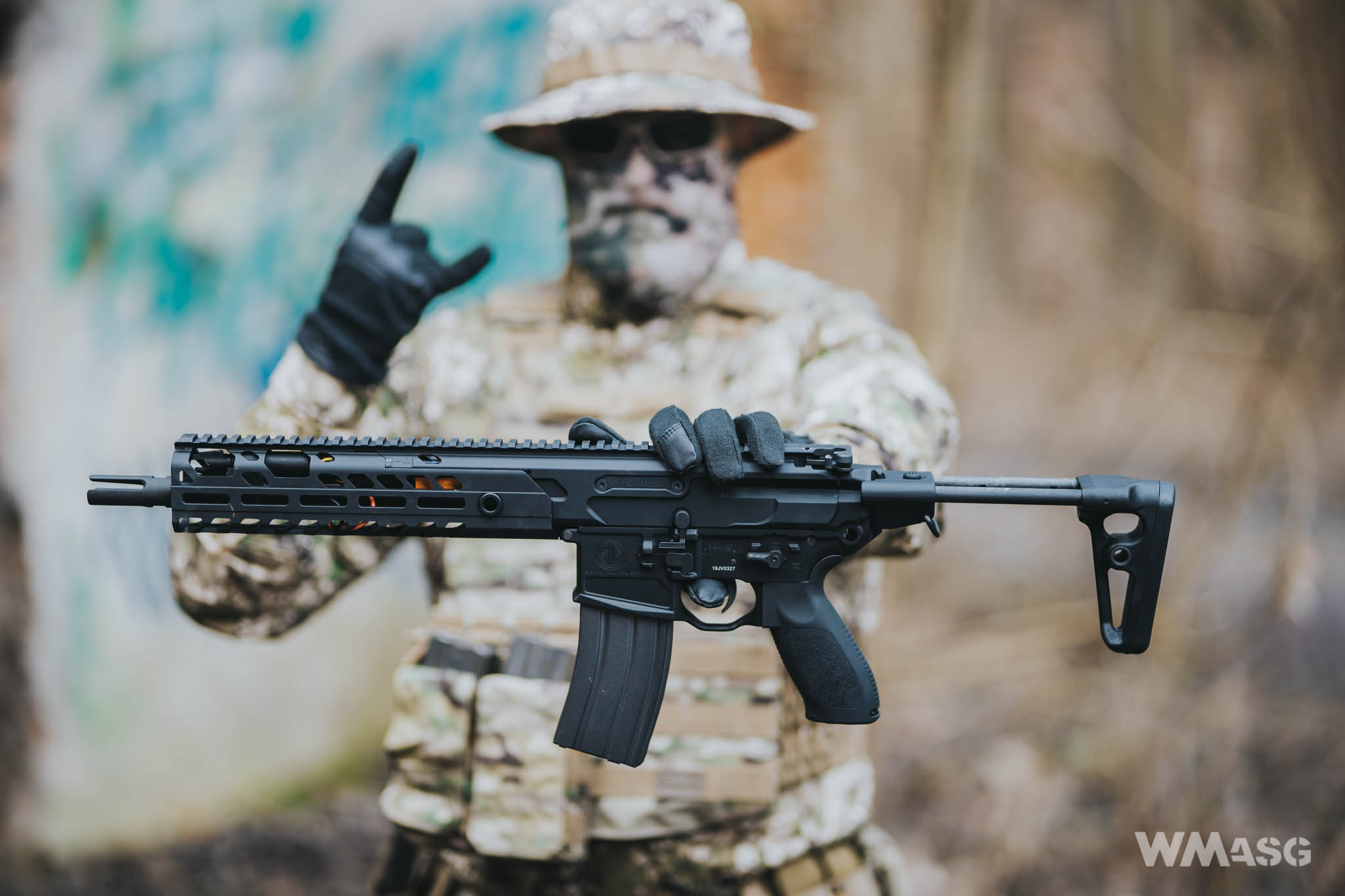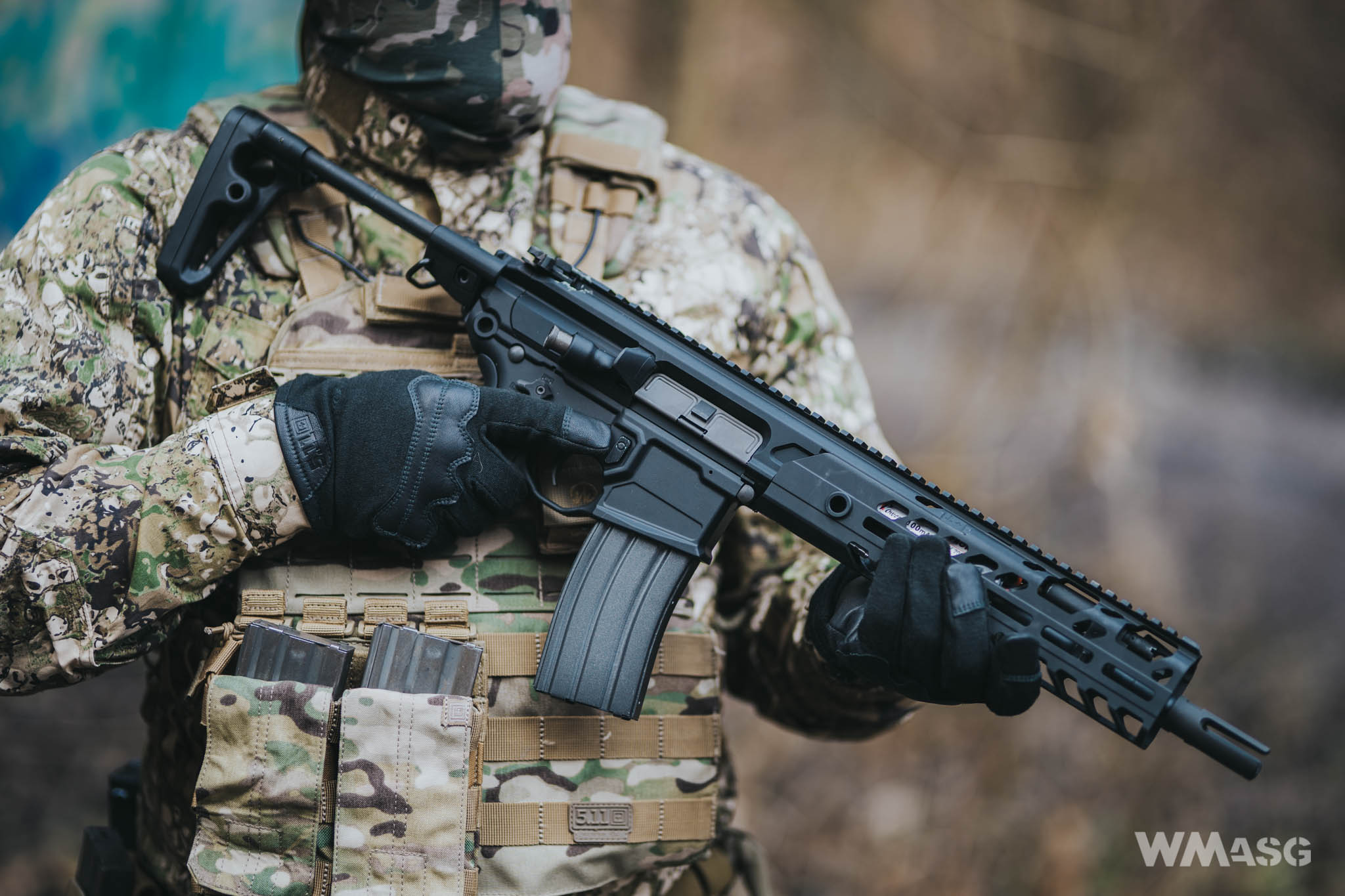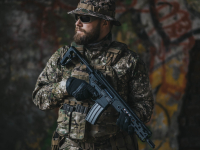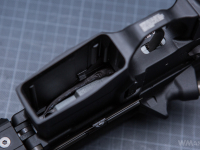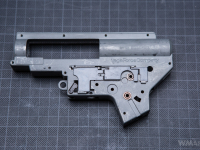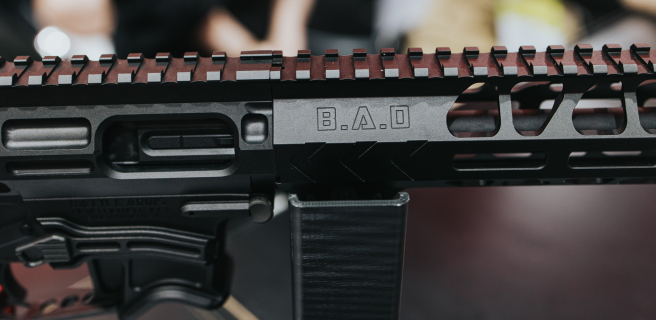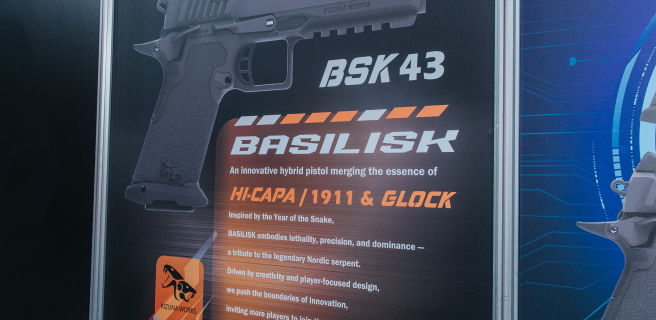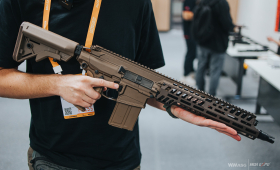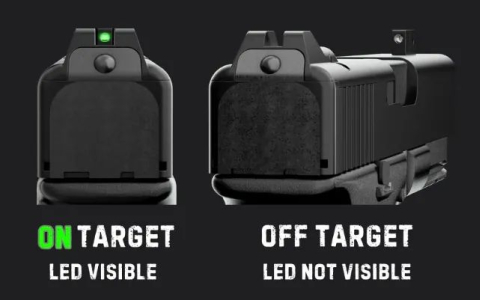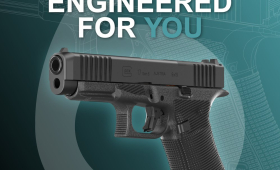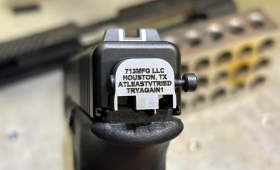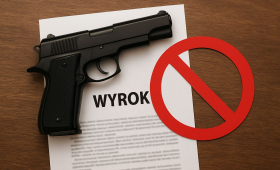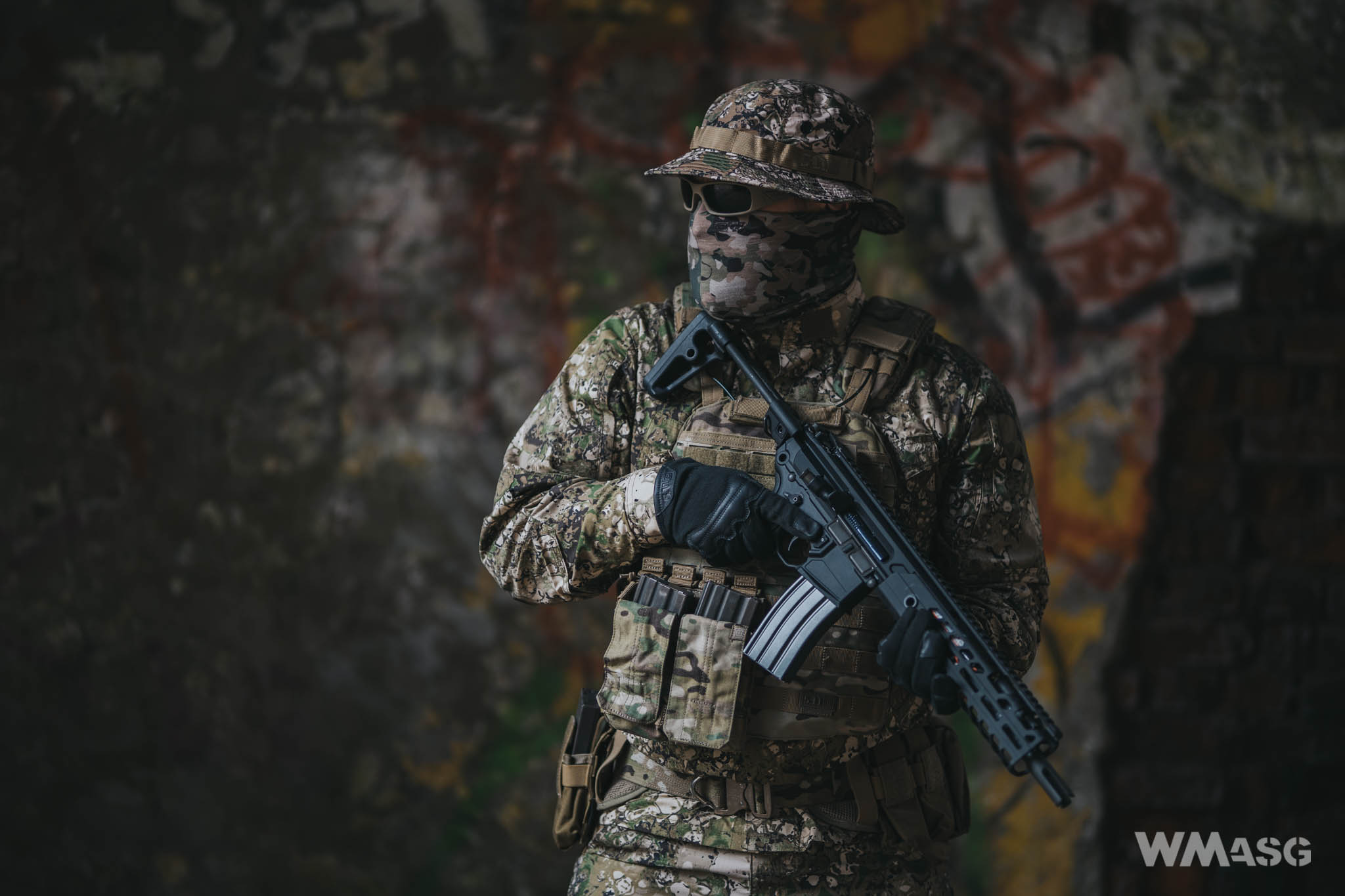
As it has been announced, the MCX Virtus replica hit stores in December last year. We are lucky to be one of the first to receive a test copy and thus we can share our observations with You.
The current model is the first Virtuus, but not the first replica of the MXC carbine. Previously, a licensed version was produced by VFC for Cybergun. At present, Sig no longer grants a license - the manufacturer of the revived replica is Sig Air - a branch of Sig Sauer dealing with airguns. This is how it looks from the formal side. In practice, the new MCX Virtus is still being made at the VFC factory. The photo below shows both models - the MCX made for Cybergun in the back, and the new MCX Virtus in the foreground.
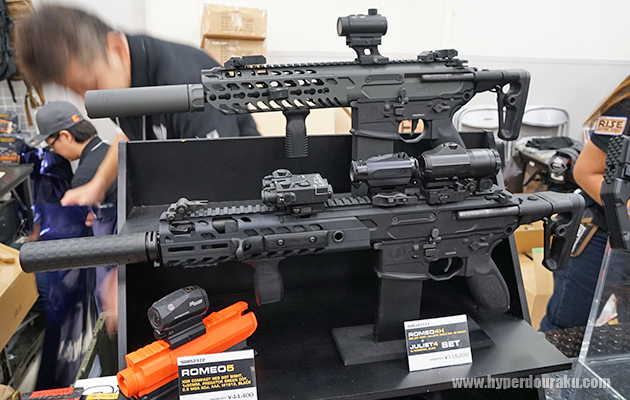
The most important differences visible immediately are the overall length and the length and type of the handguard used. The Cybergun's MCX had a length of 580/675 mm (collapsed/extended stock), and the new Virtus is 640/740 mm respectively. Cybergun's handguard was made in the KeyMod standard, the Virtus is using a slightly longer M-LOK model. Of course, this results in a difference in the length of the inner barrel - Cybergun had a 230 mm long barrel, and the Virtus has a 295 mm long barrel.
In the original, the Virtus line is distinguished by a 2 stage Matchlite trigger, a forged barrel with increased profile and bolt lugs shape. Both 5.56 and 300 Blk versions are available.
The MCX and the MCX Virtus only very vaguely resemble the AR-15 system rifles. In fact, it is a completely redesigned weapon. The main difference is of course not the piston system which, after being introduced in the HK416 is used more and more often by many manufacturers. The most important thing is the replacement of the return mechanism, which in ARs is located in the buffer tube, with a system of 2 springs working on the guide rods located in the receiver above the bolt carrier. Thanks to this, it became possible to use side-folding stock. It became obvious that the overall length of the weapon could also be shortened.
On Sig Sauer's website you will not find a model that is visually identical to the MCX Virtus replica. There are rifles with the same length of handguard and barrel, but with a fixed length stock folding to the left. Visually, the replica is closest to the Pistol model (pictured below). Yet, in weapon stores you can already find Virtus models with a PDW type telescopic stock, as the one used in the replica. This is a proof of the modularity of the design as you can use different stocks, handguards and barrels. The combustible MCX Virtus Pistol is designed for 5.56 NATO and 300 Blk rounds.
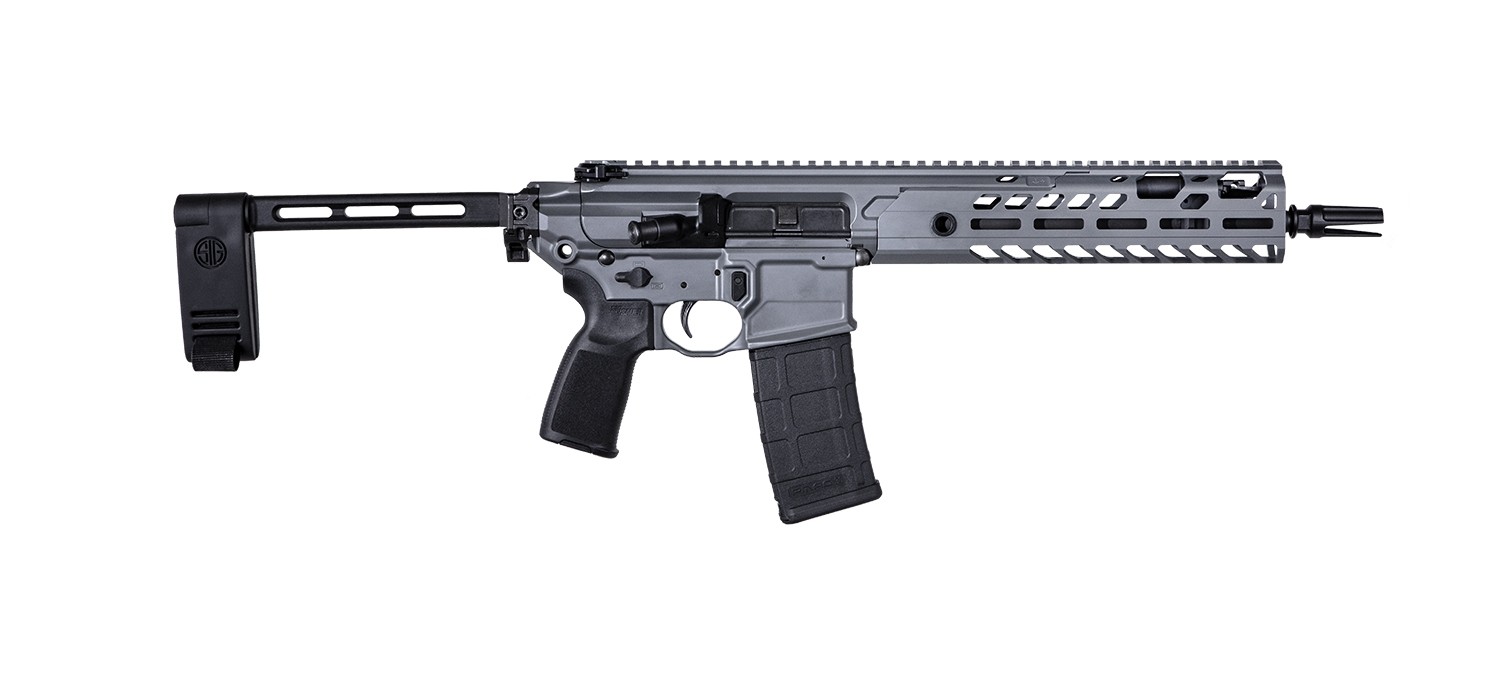
Sig ProForce MCX Virtus
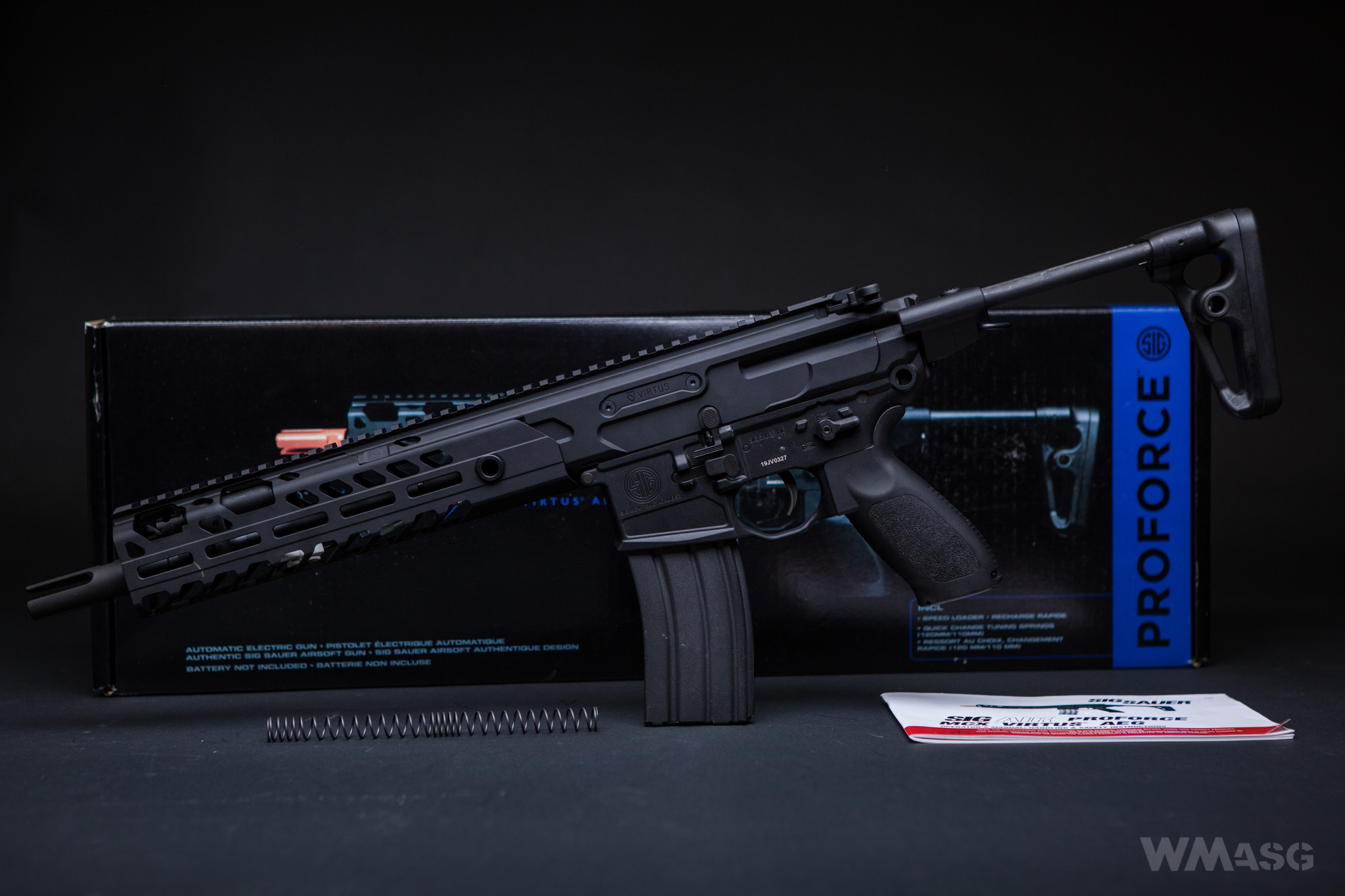
The set comes with:
- a replica;
- a mid-cap magazine for 130 BBs;
- an additional main spring (M110);
- an extensive multilingual manual (but with no section in Polish).
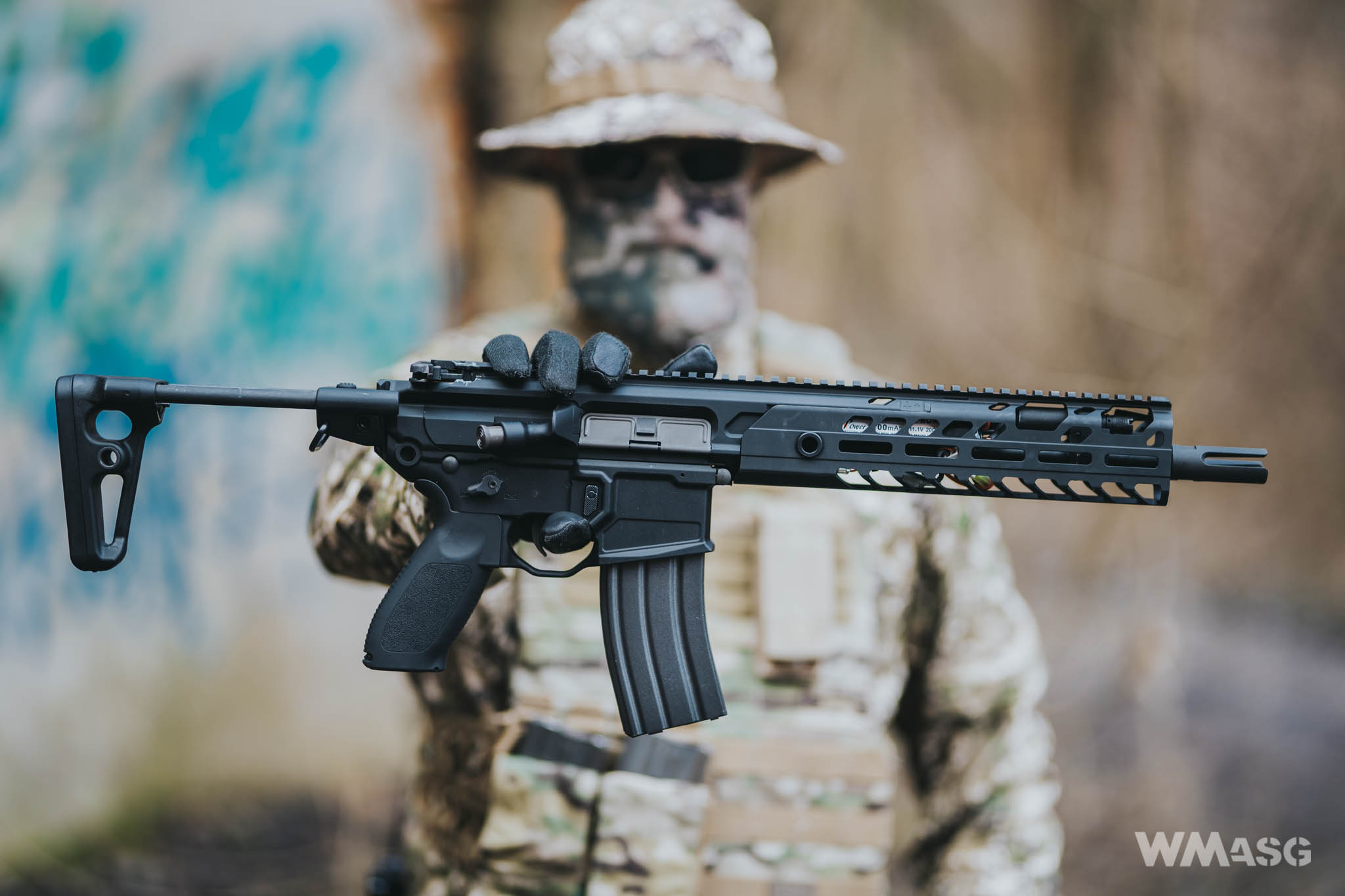
Basic technical data:
- overall length (collapsed/extended stock): 650/740 mm;
- inner barrel length: 295 mm;
- weight: 3000 g;
- muzzle velocity (according to manufacturer): 390-420 fps;
- gearbox: standard V2 frame with the possibility of quick spring replacement;
- electrical installation equipped with mosfet.
Appearance and external design
There will be no surprises here - the Virtus looks very good and really very reliable. Of course, we had no way of comparing it to the real carbine thus the previous statement is just a subjective opinion. Externally, it looks a bit like an AR, but no part is compatible with anything. The manufacturing quality and fitting of the parts are excellent. The replica is stiff, the upper receiver fits perfectly with the lower receiver, it has no slack ... Well, almost ... The aluminum handguard, despite being mounted on guide rails and and tightening it with 2 noticeable screws, wobbles and rattles. This is the only drawback seen during the first contact with the replica. The handguard has 5 M-LOK slots on the sides and the bottom. The Picatinny rail is paled on its top, which is perfectly aligned with the rail running on top of the upper receiver. The fitting is so perfect that it is really difficult to notice the contact point, which is moved slightly to the front compared to most other ARs. It is placed exactly between the second and third M-LOK side slots.
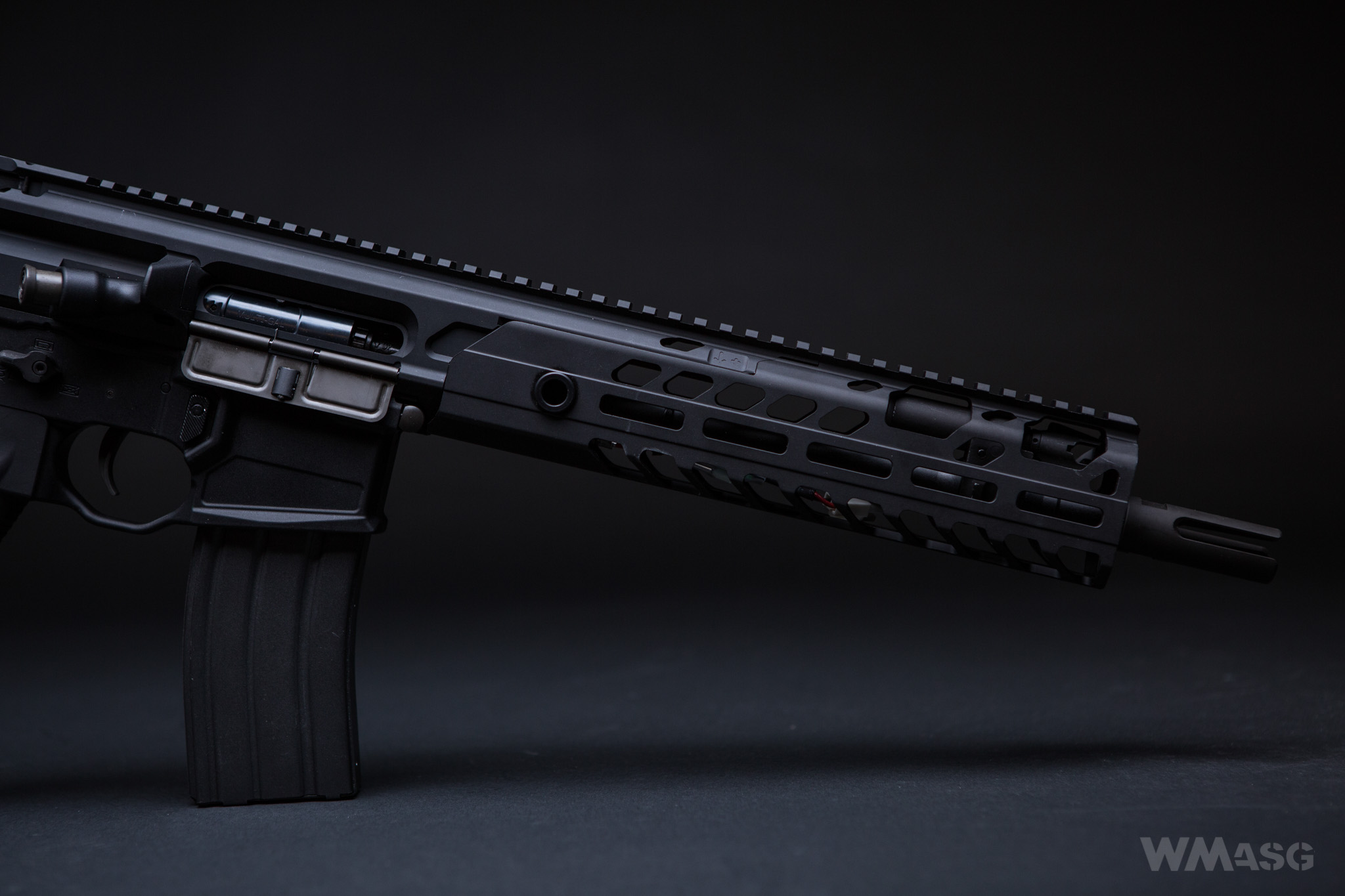
It can't be seen from this perspective either. However, you can see that there are no sights included with the replica.
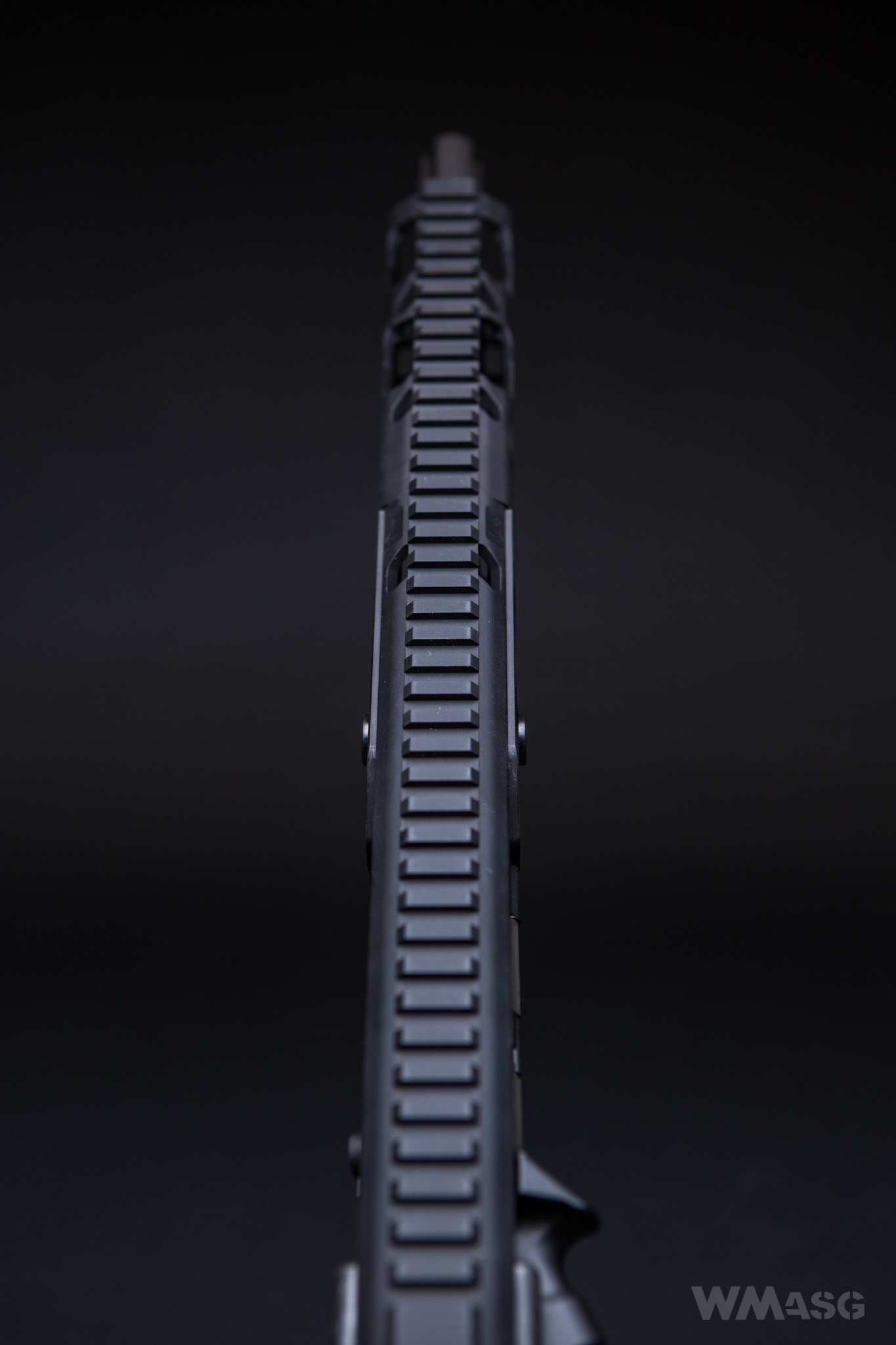
A large port, just before the end of the handguard, gives access to the gas regulator. In the replica it serves absolutely no purpose, but one can turn it. The regulator has no specific settings and it won't click into any position thus it can be turned as one wishes. In the recently reviewed Arcturus GR16A5 the regulator had 2 distinct settings. In that case the manufacturer tried his best. Fortunately, the design of the MCX valve is such that it cannot be unscrewed and lost. Below, the gas block with the regulator removed. The pins are dummies as the block is mounted on the barrel with 2 Allen setting screws. The dummy thread of the regulator is visible.
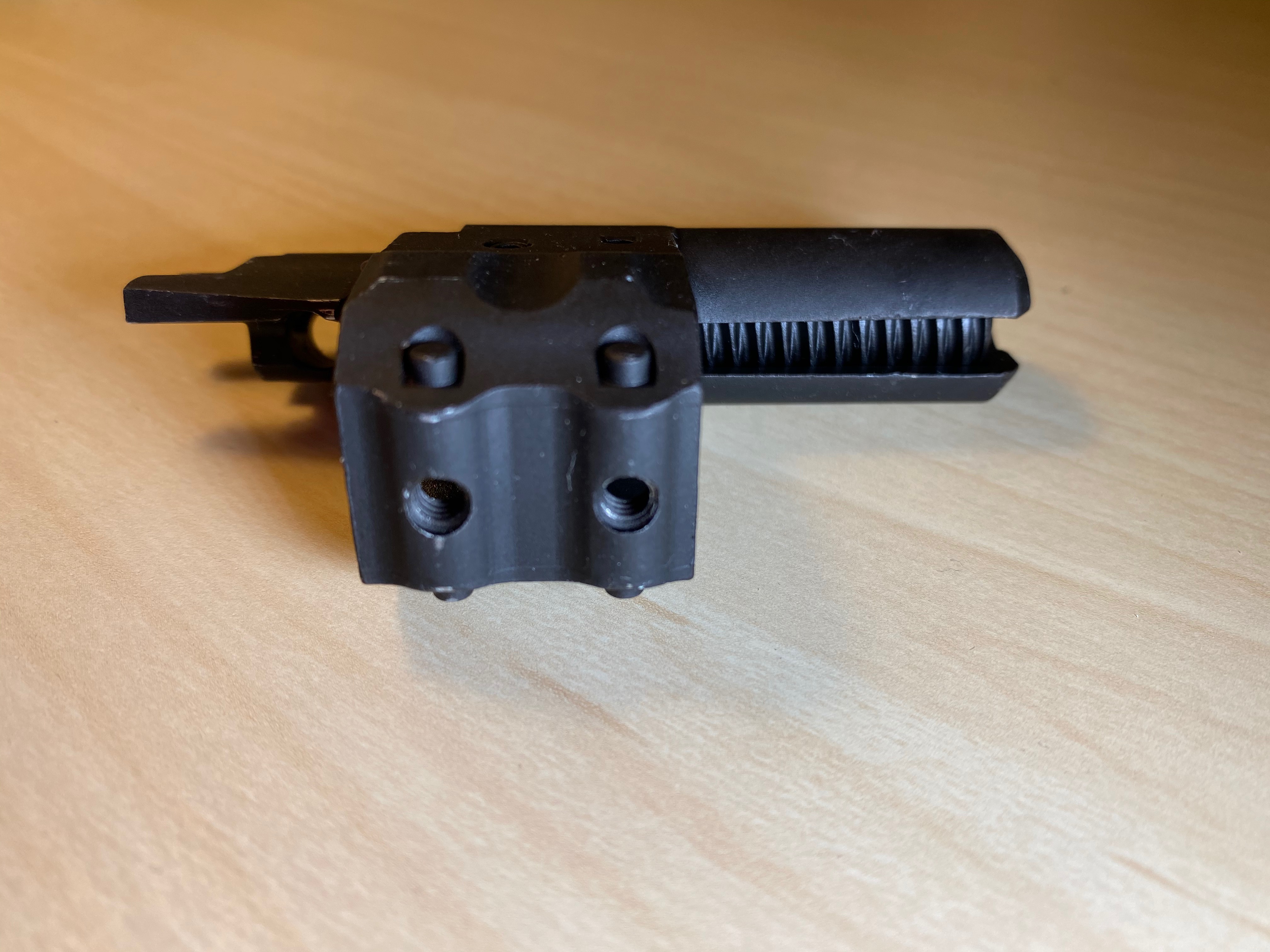
The flash hider has 3 notches and is mounted, traditionally, on a 14mm CCW thread. However, it is not secured in any way, so you either need to really tighten it or use thread glue. Below is an example of how to use a silencer instead of a flash hider.
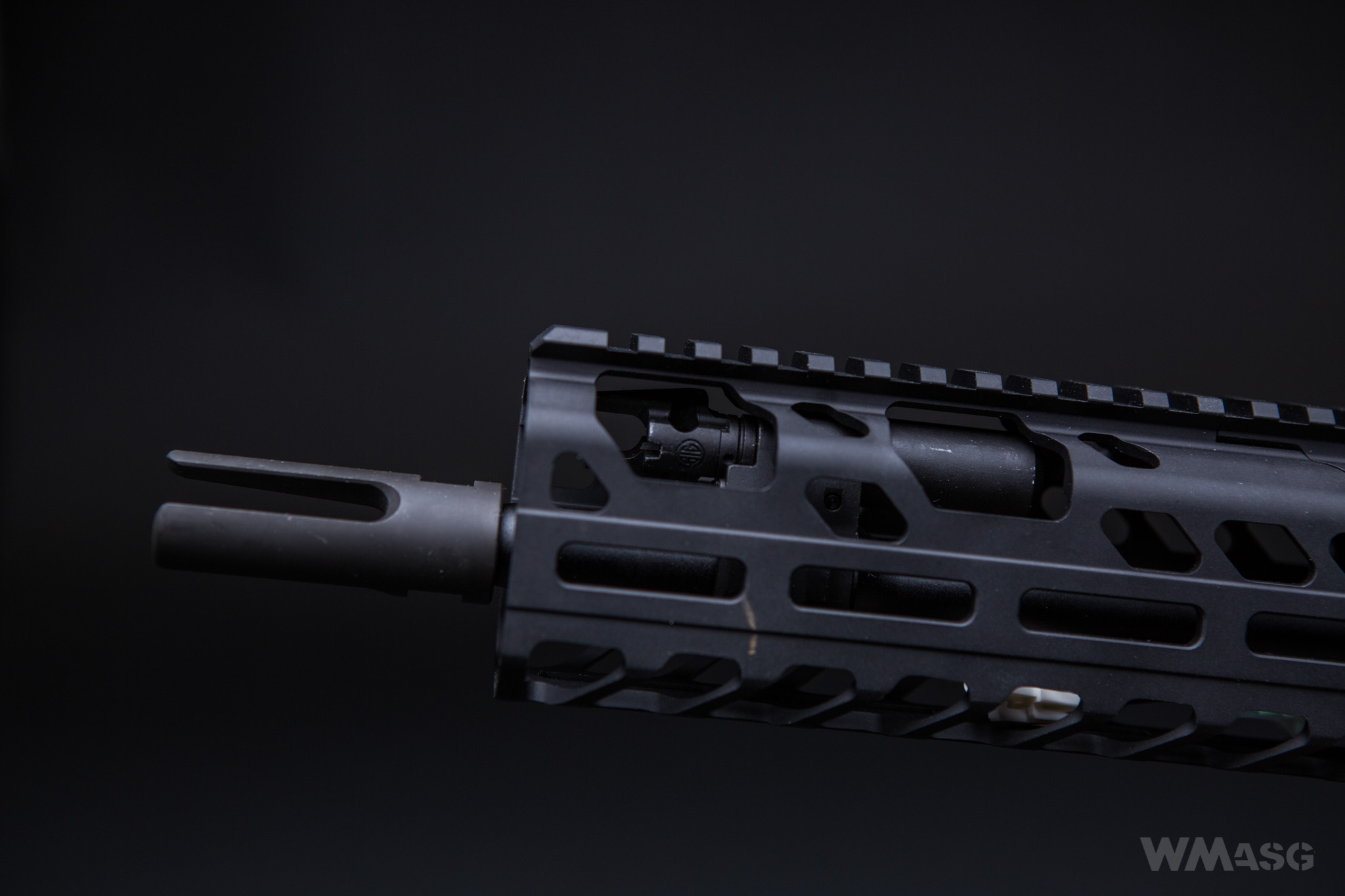
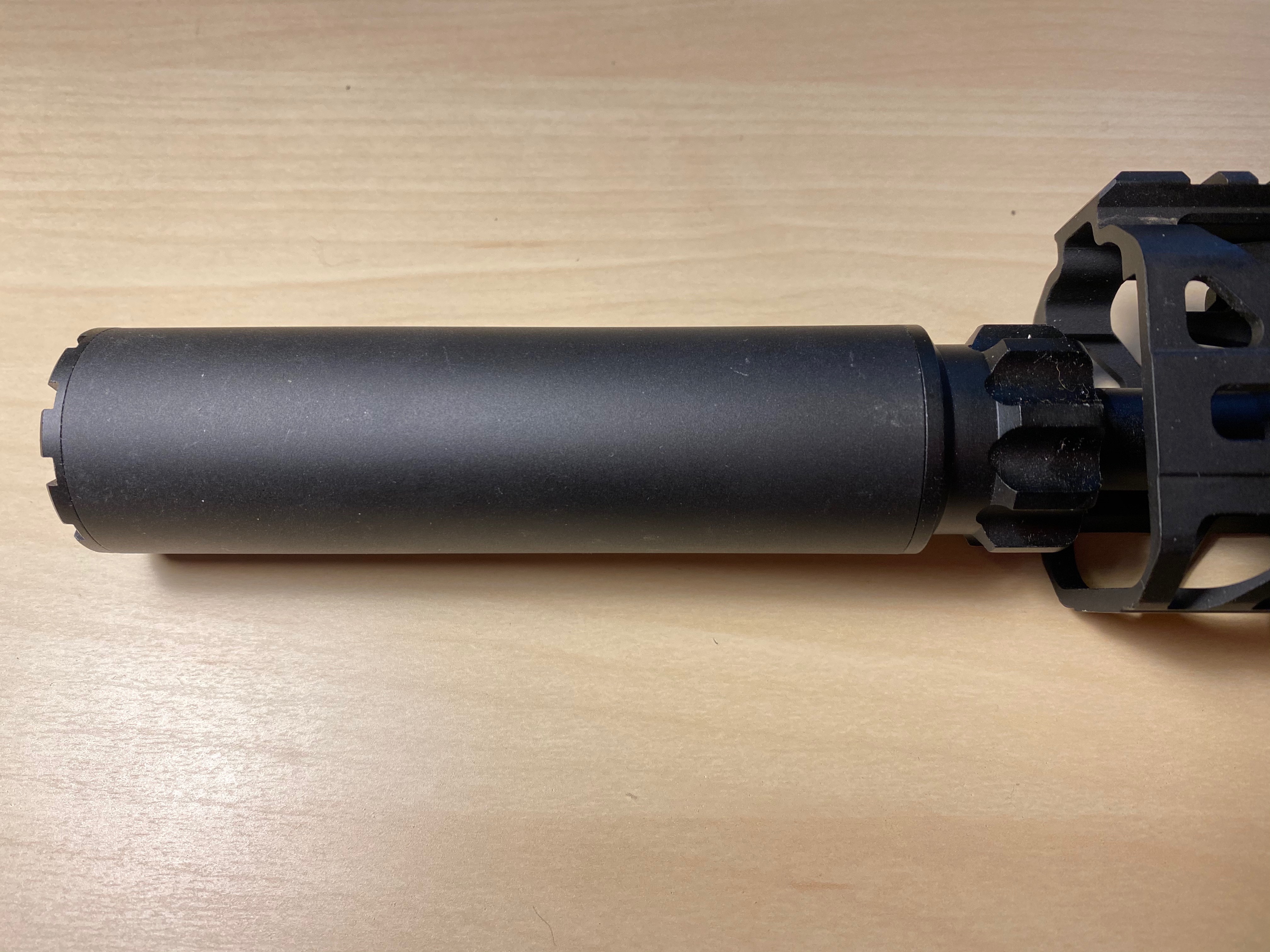
On the left side of the carbine's receiver standard manipulators have been place. They consist of the safety/selector switch, which has three settings, the magazine release button and the bolt catch. All markings are made very carefully and are deeply engraved. Only the serial number is applied using a different technique. We were intrigued by the plate with the "Virtus" inscription. We checked and it doesn't have a slightest role in the workings of the replica.
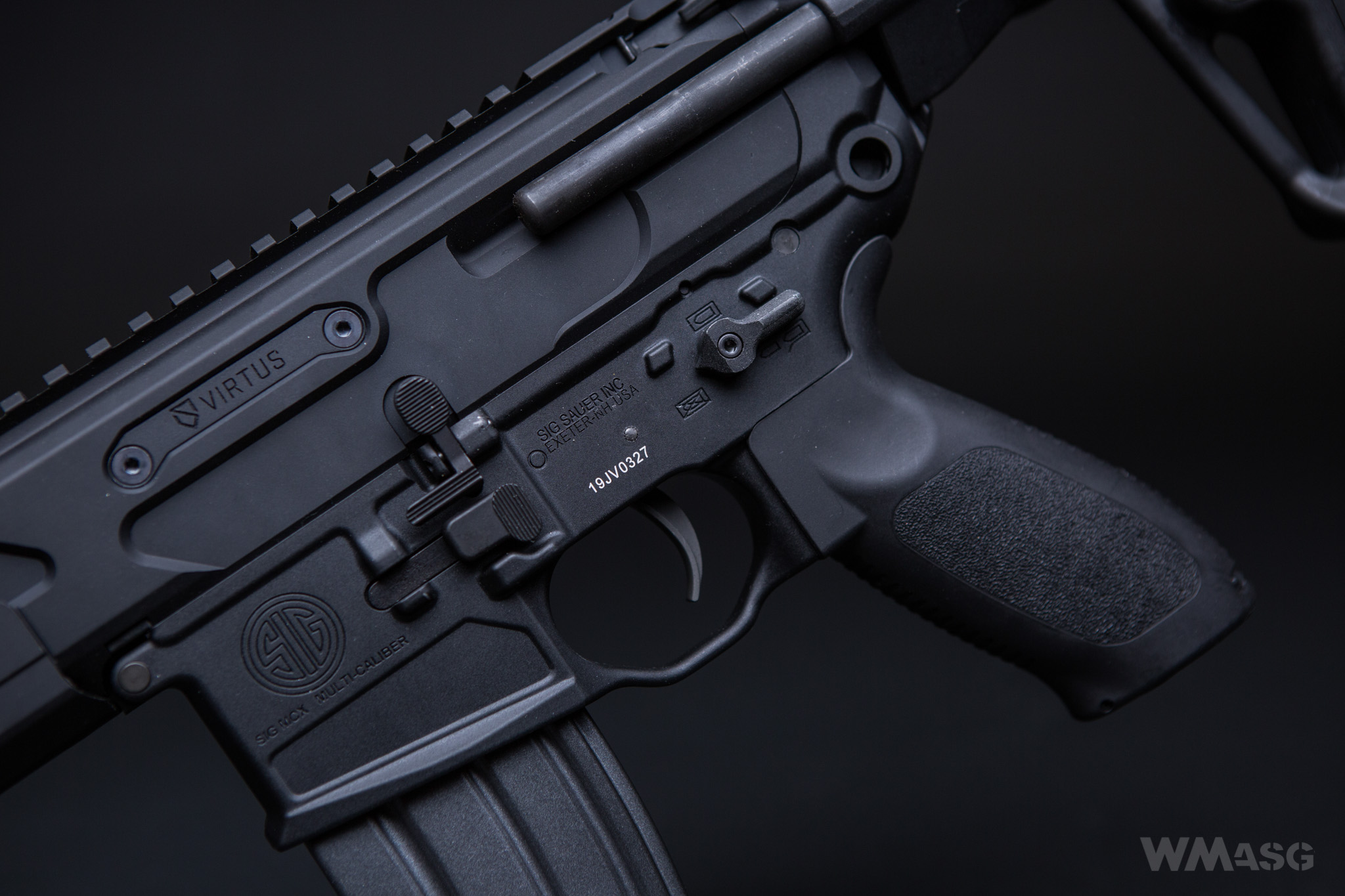
In the rear of the lower receiver there is a QD socket used for mounting the carrying sling swivel. Other sockets are placed on the handguard and the stock. The same QD socket layout is repeated on the right side of the replica. On the right side of the receiver we will find a traditional ejection port closed with a cover, a deflector, a forward assist button, a second magazine release button and a second safety/selector switch. It is worth noting that the said selector works smoothly and softly, clearly clicking when changing the settings.
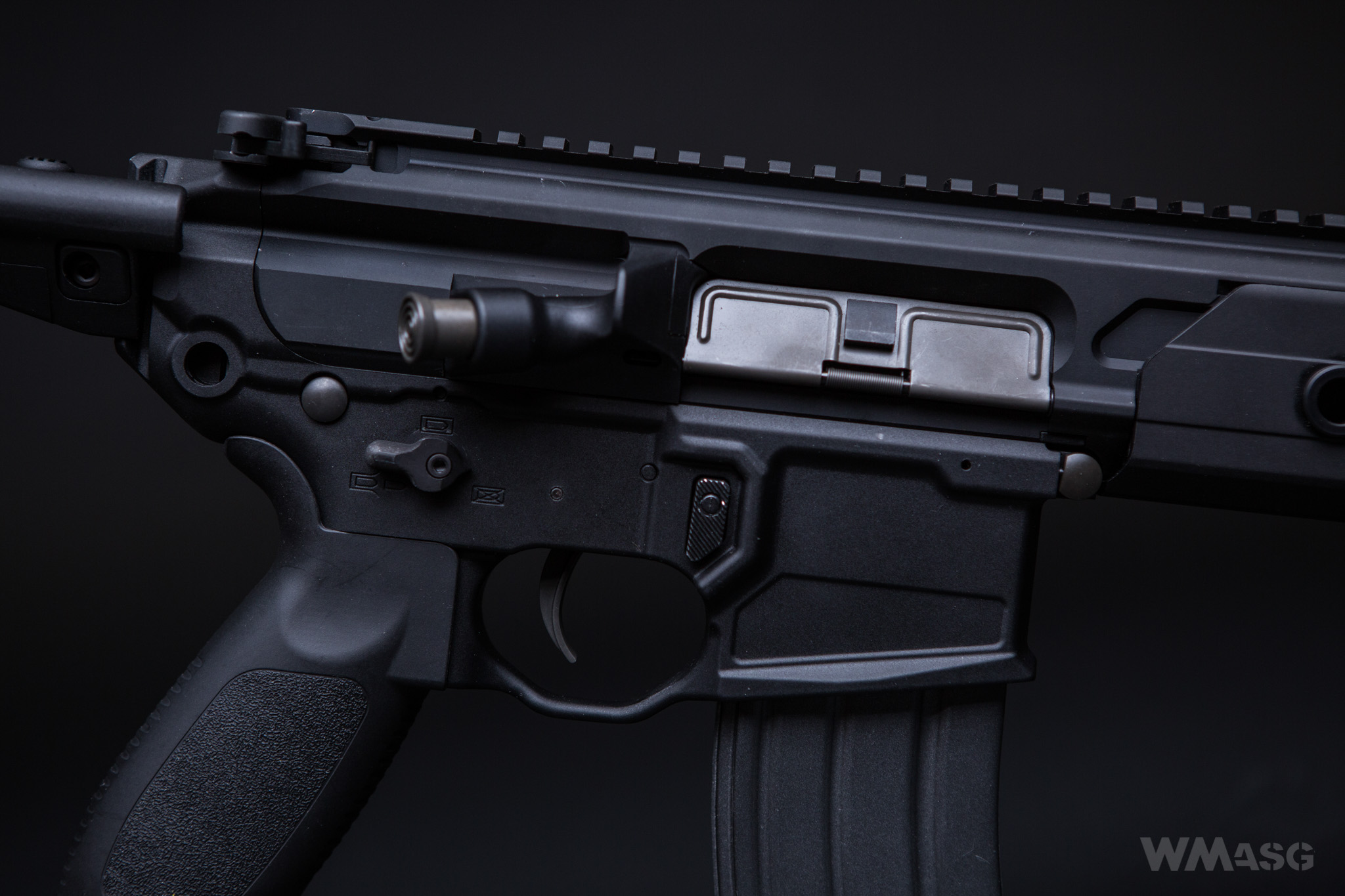
The pistol grip is similar to the one used in the HK416 carbines, but in Sig, which is also our subjective opinion, it fits a bit better in ones hand.
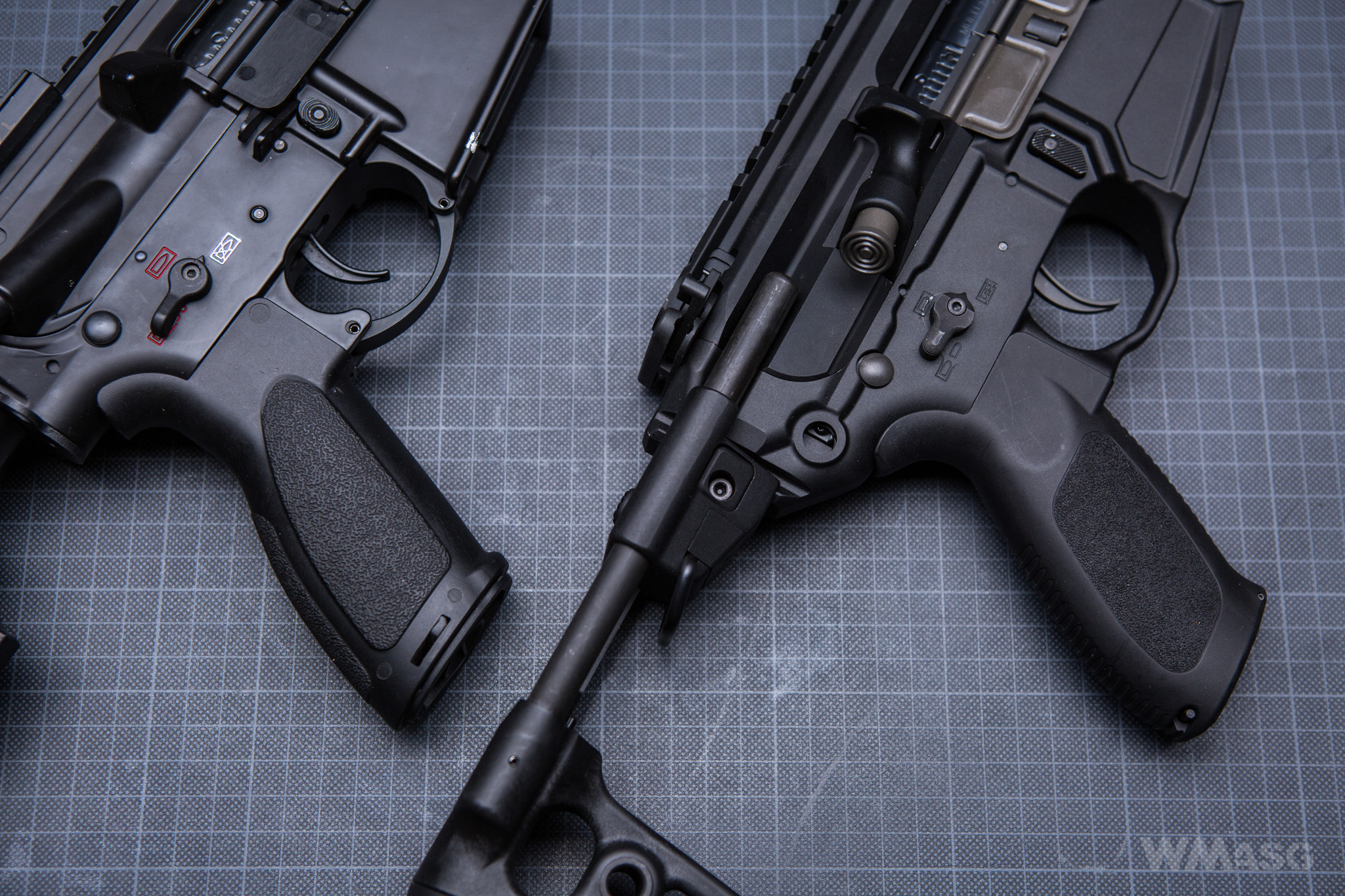
Handling
Connecting the battery
Space for the battery is provided inside the handguard. Unfortunately, you need an Allen key to access this space because the handguard is secured with 2 screws.
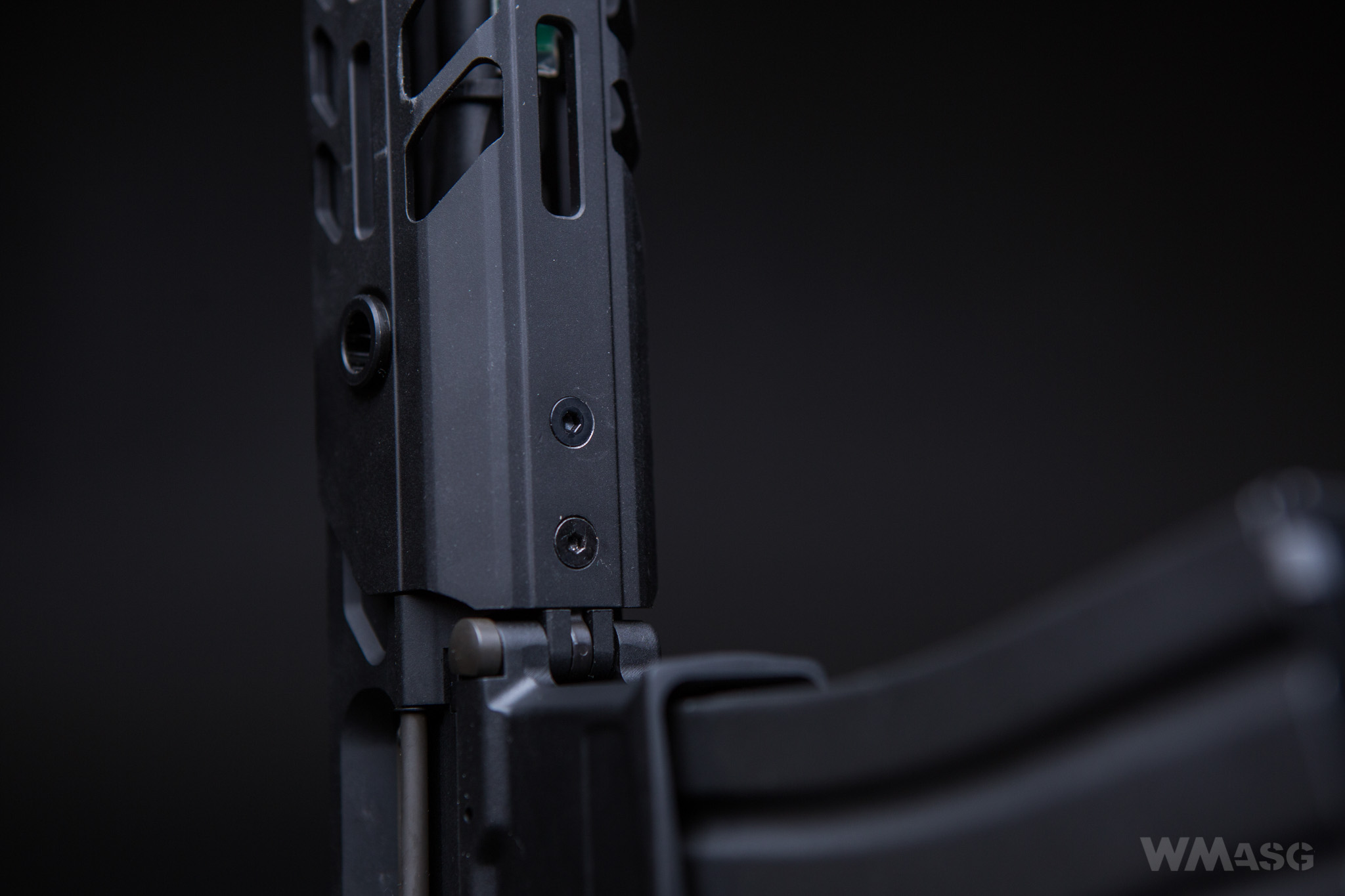
During our tests, we used a two way nun-chuck 11.1V 1200mAh LiPo battery that could easily fit inside the handguard. A battery of much larger capacity could probably be also fitted there , but it would have to be a three way nun-chuck type. While inserting the battery did not cause us difficulties, putting the handgaurd back on proved to be a considerable challenge. Short rigid wires, a fuse plate and a mini Tamiya connector were getting caught in the M-LOK slots every now and then.
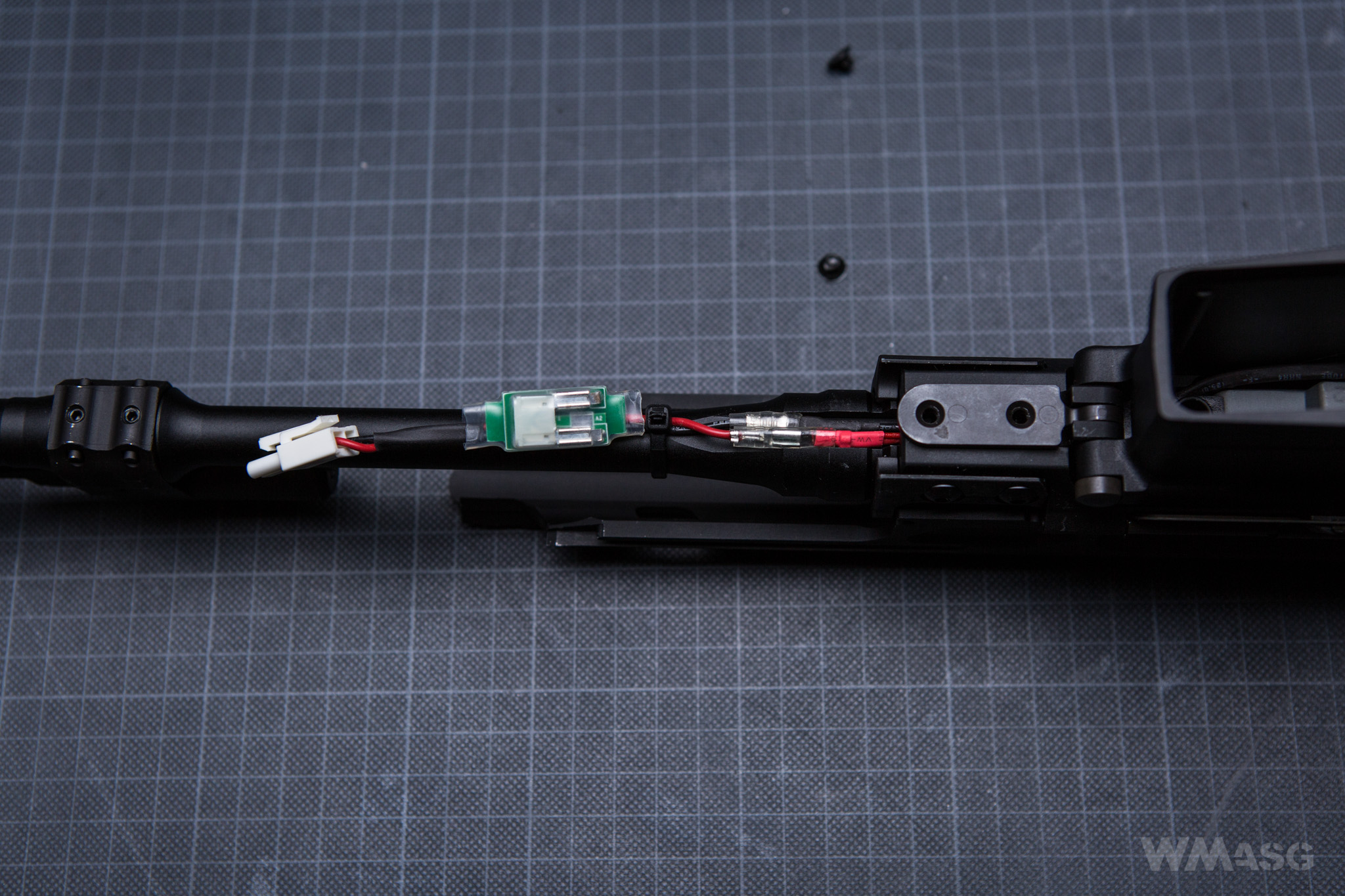
The end result looked like this:
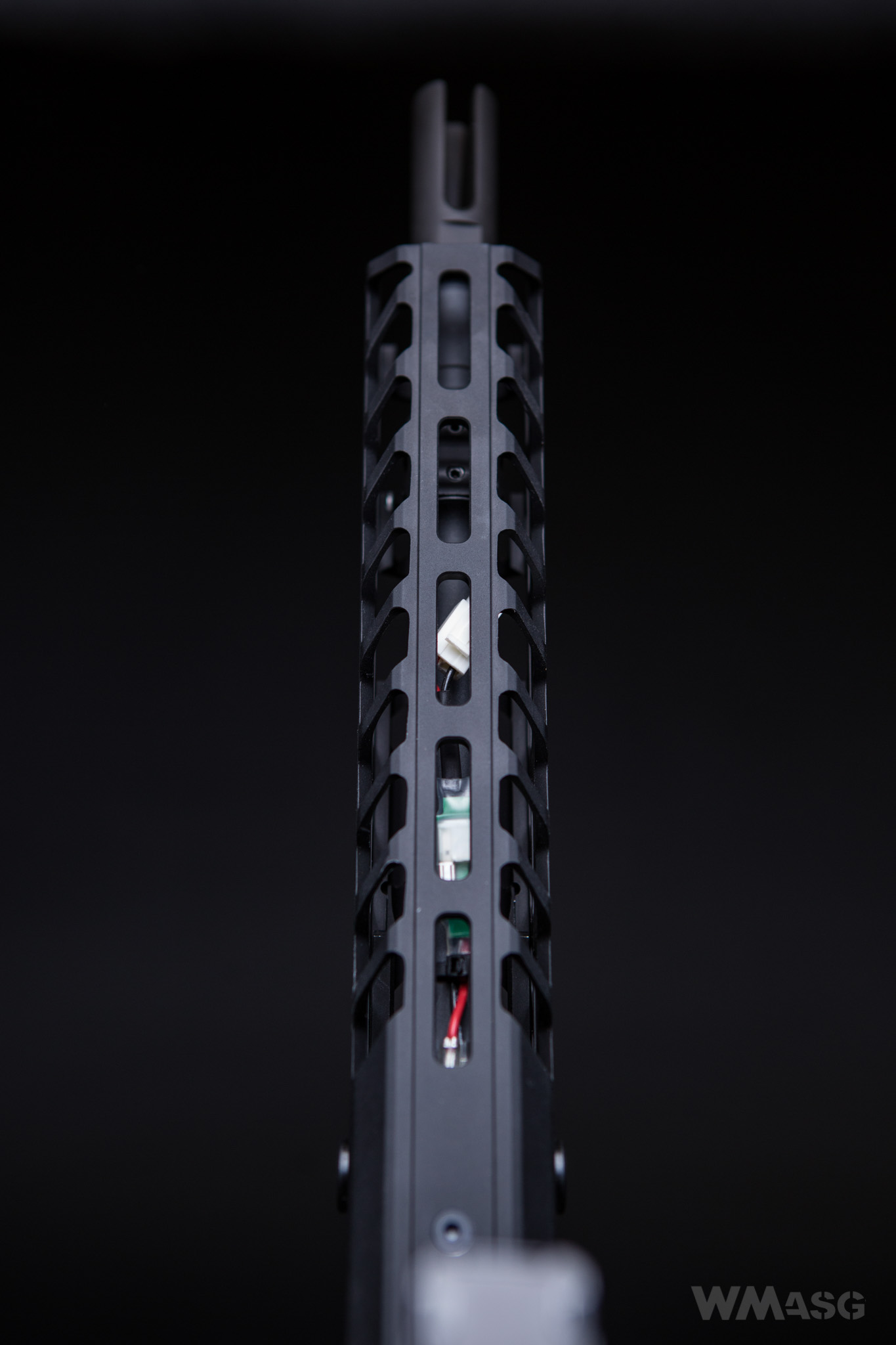
Unfortunately, because of the ports in the handguard, it will never look better. The battery, the wires, the fuse and the plugs are clearly visible. Even wrapping everything with black tape won't help much.
HopUp adjustment
Access to the adjustment is obtained by pulling the changring handle, equipped with 2 latches, back. The dummy bolt carrier stops in the rear position during adjustment, and charging handle along with it. The adjustment itself is precise and convenient thanks to the chamber equipped with a ring, although in the reviewed replica the HopUp spun 0.25g BBs a bit too much for the muzzle velocity achieved. After adjustment is done pressing the bolt catch will causes a surprisingly dynamic return of the dummy bolt carrier with the charging handle to their resting positions. This is due to the replacement of the traditional single spring system of 2 springs, which are similar in appearance to the return spring assembly of the real carbine.
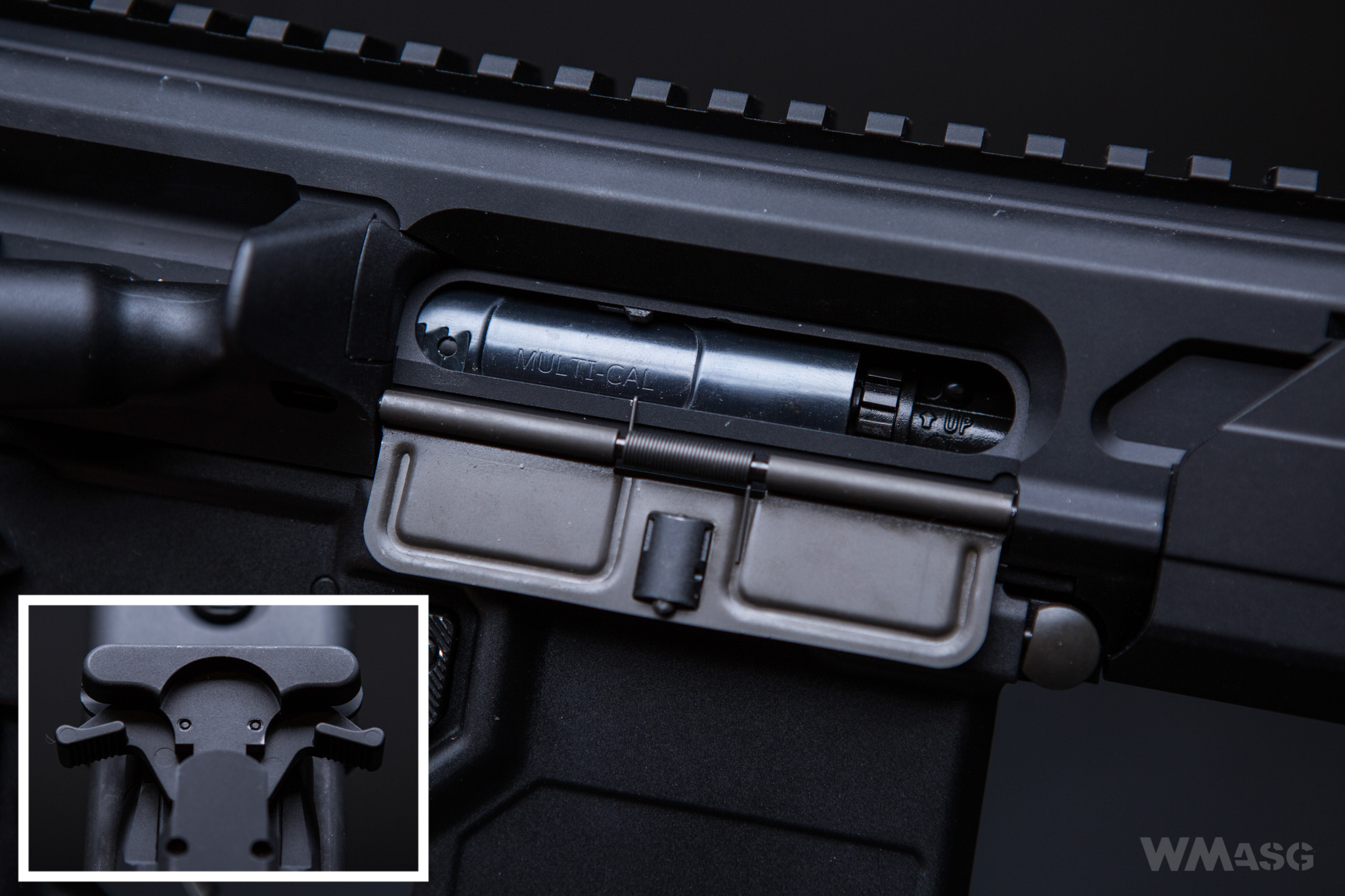
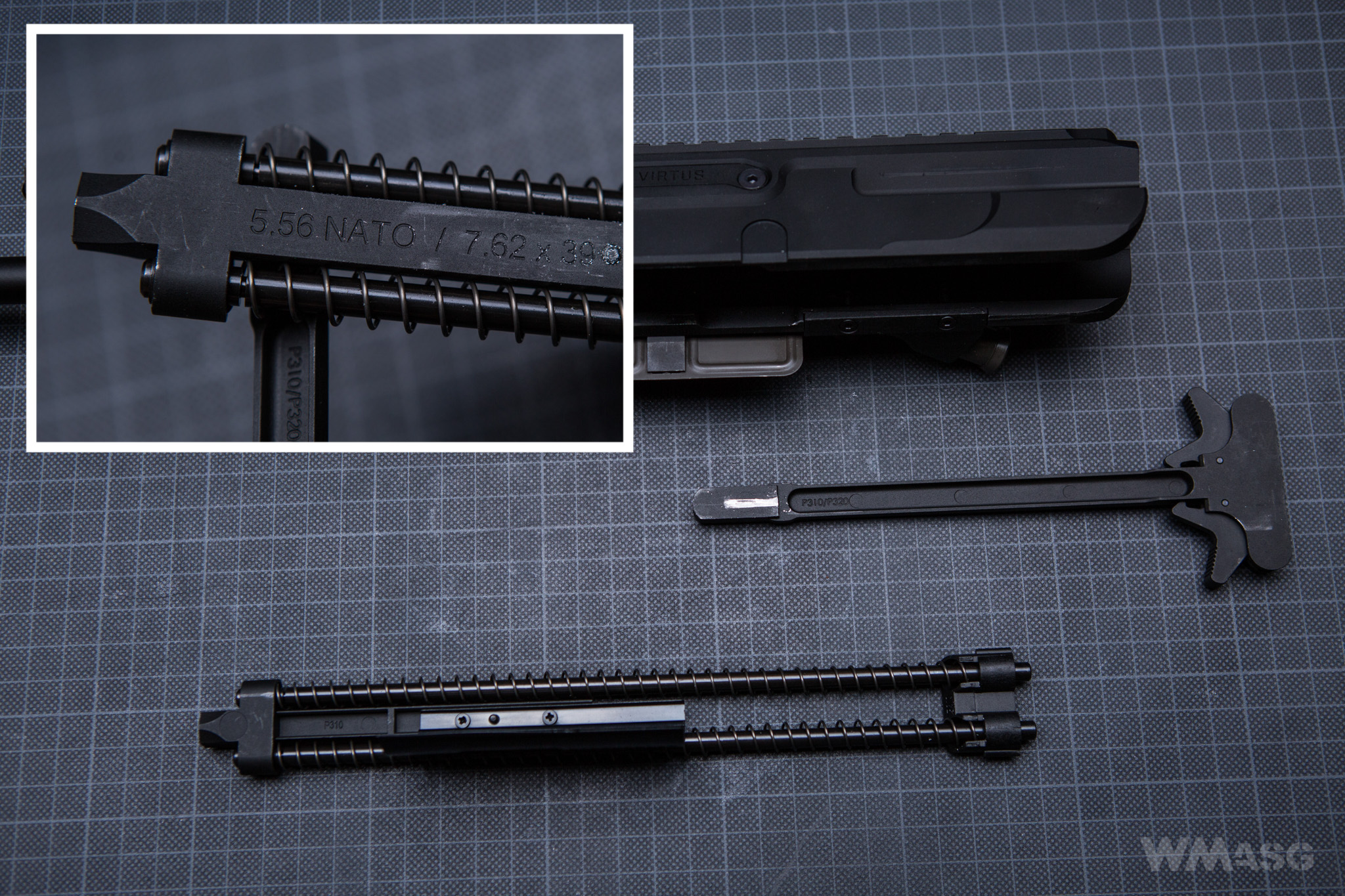
Attention to detail, such as the markings of the caliber on the normally invisible part is somewhat surprising considering the fact that under the openwork handguard there is no dummy gas piston.
Stock length adjustment and spring change
The PDW style stock used in the replica is the only one from the MCX system which is not folded to the side but collapsible one. The button for changing the settings is in the upper part of the mount. Apart from the extreme positions, only one intermediate setting is possible.
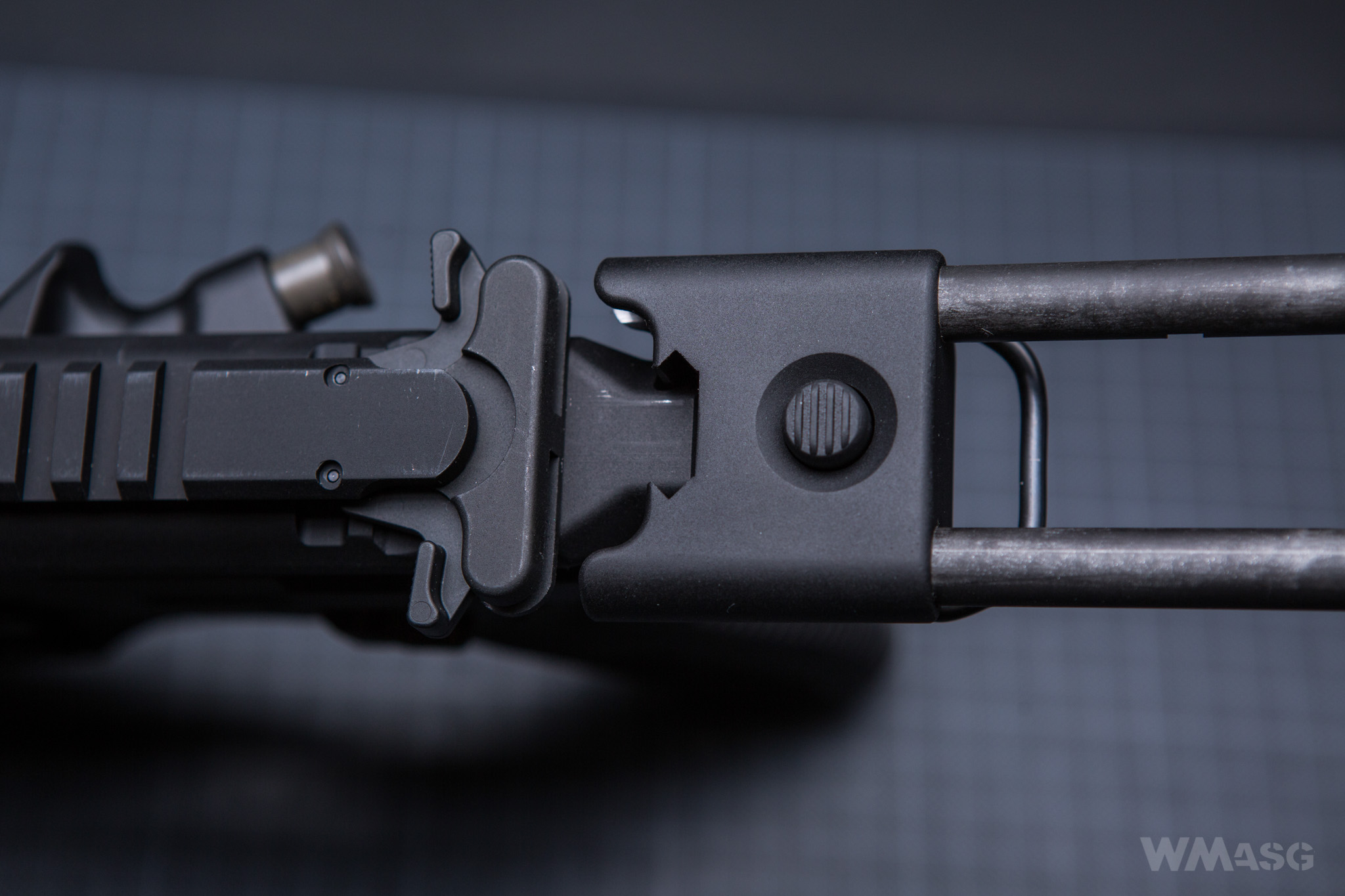
Under the button another mounting point of the carrying sling is visible. This time in the form of a steel swivel. It is slightly better visible in the photo below, which also shows the spring-loaded rod (on the left), which role is to partially extend the stock after the button is pressed. Unlike the vast majority of replicas, here it works fine as the rod's spring is strong enough to extend the stock to approximately 1/3 of its length.
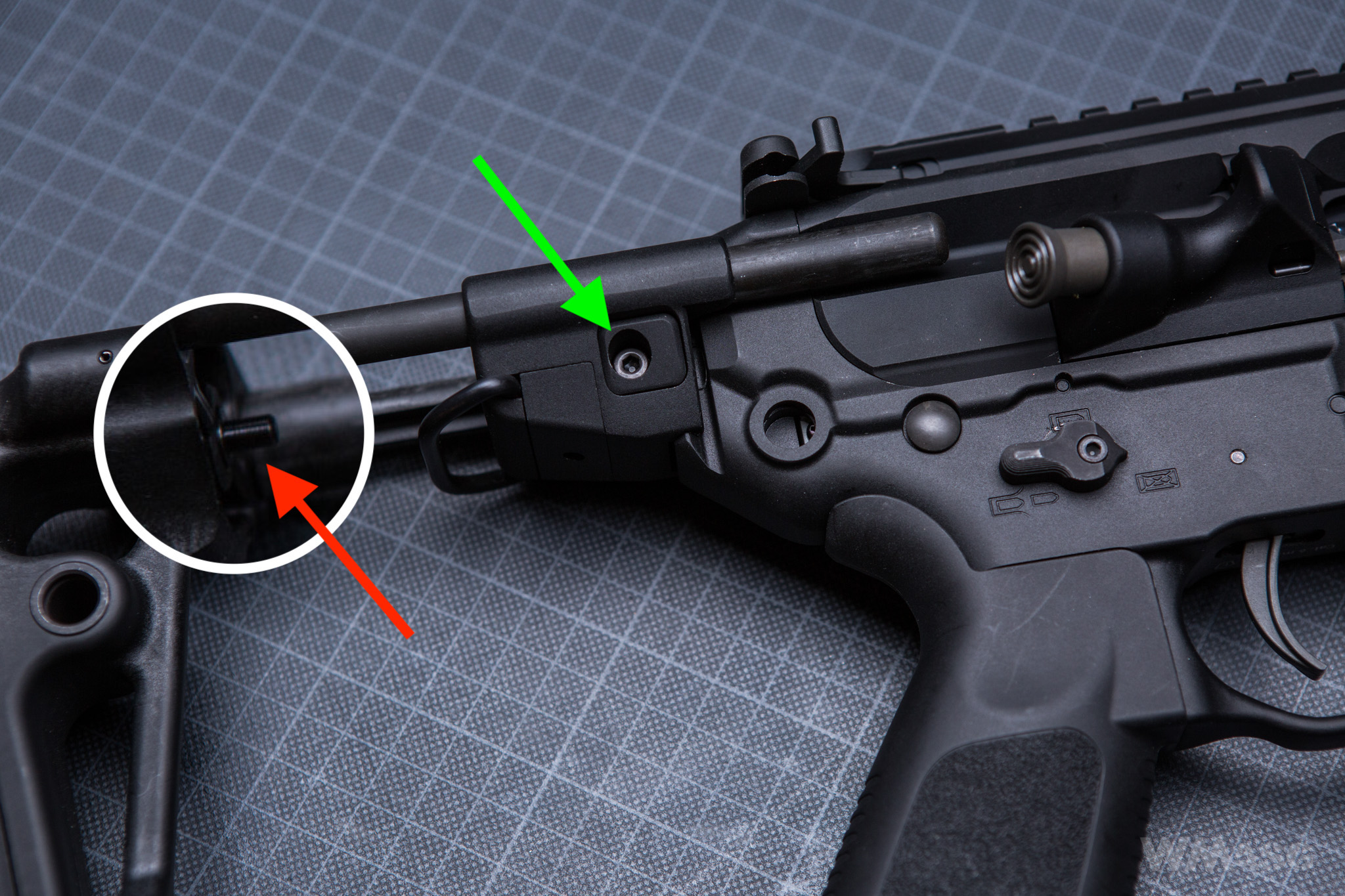
And since we are talking about the lengths ... Even a fully extended stock is short enough to force a very compact firing stance. Regardless of whether you like to hold your weapon right next to the magazine well or is a fashionable way a la Costa, with your hand extended, your other hand will be bent at the elbow anyway, and you will be a smaller target. The distance from the end of the stock to the pistol grip for the reviewed Virtus is 23 cm (9.05 in). For comparison, the same distance in the HK416D10RS replica with a CTR type stock, in its maximally extend position is 30cm. The difference seems to be small, but try to shorten something by 7 cm.
In the photo above, the green arrow indicates the screw that secures the stock to the Piactinny rail located on the replicas receiver. After unscrewing it, you can slide the stock off and gain access to the spring guide.
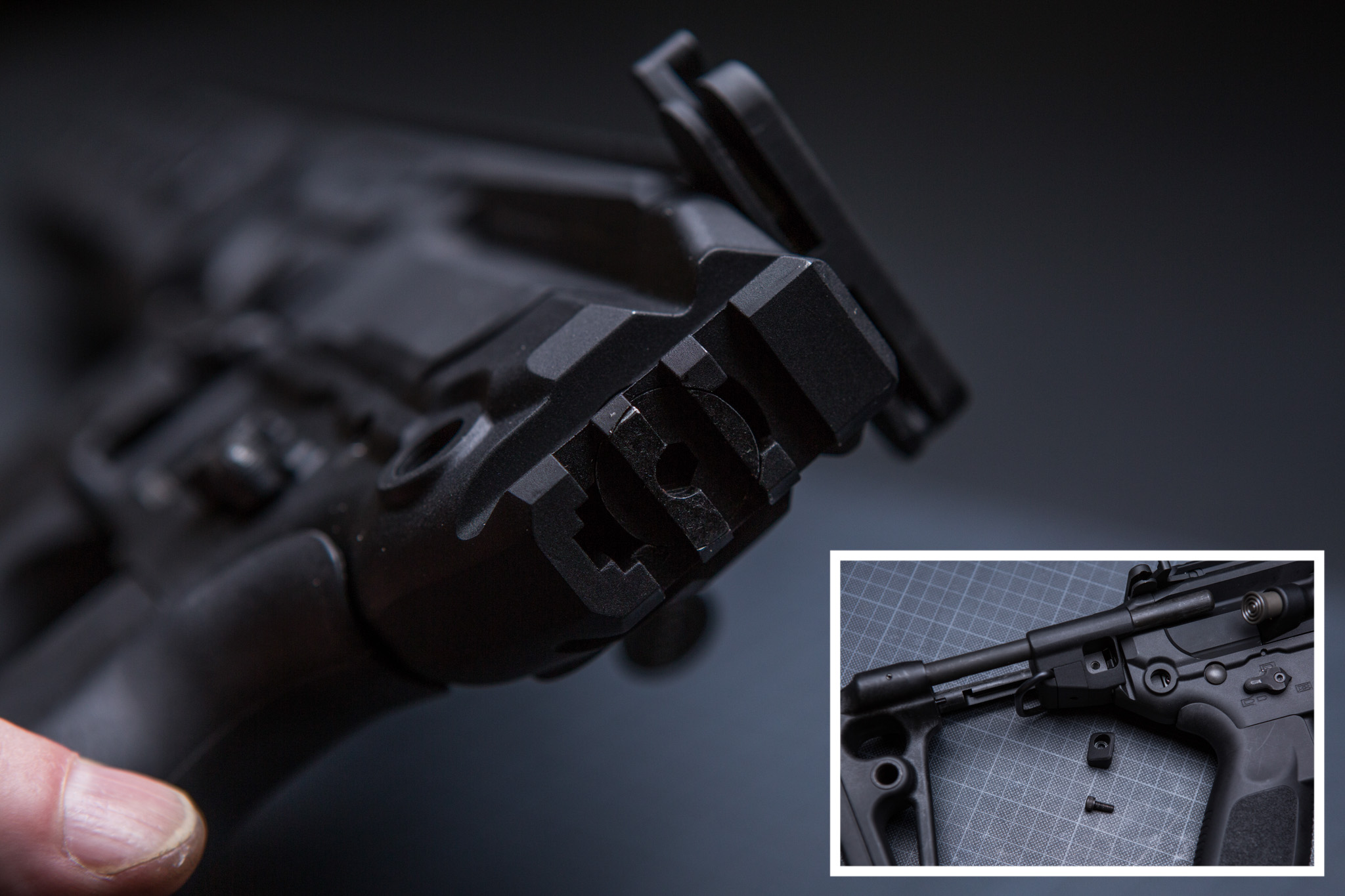
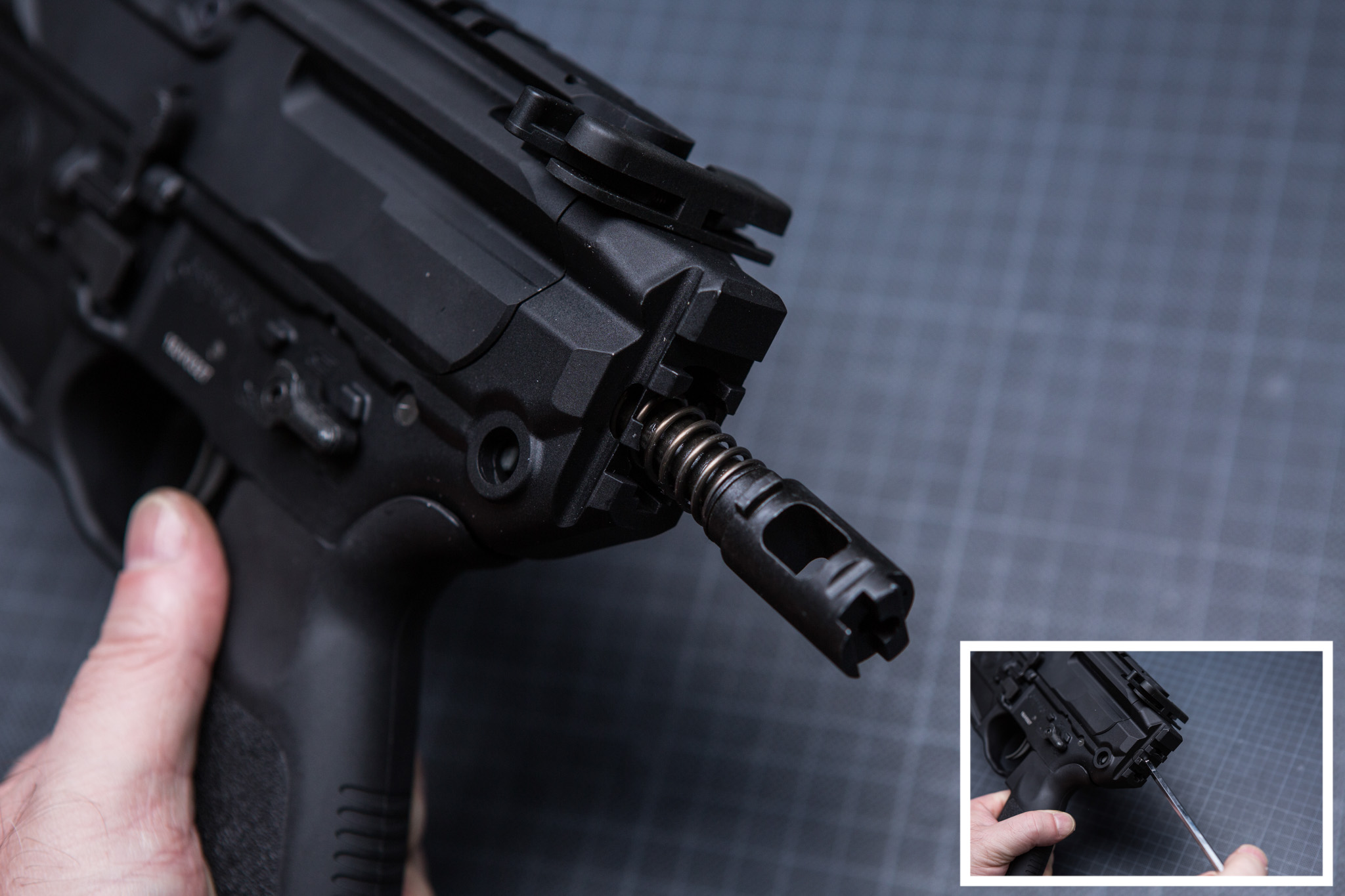
The gearbox
The replica is driven by a standard V2 gearbox. The disassembly of the replica, in order to remove the gearbox, is done like in most ARs: we take out the front pin and slide the upper receiver off the lower receiver. But first, unfortunately, it is necessary to remove the handguard and disconnect the flat connectors of the electrical installation, otherwise the wires can be easily damaged. Next you need to remove the pistol grip, the magazine release, the bolt catch and take out the 2 remaining pins. In short, all in a way typical for AR type replicas.
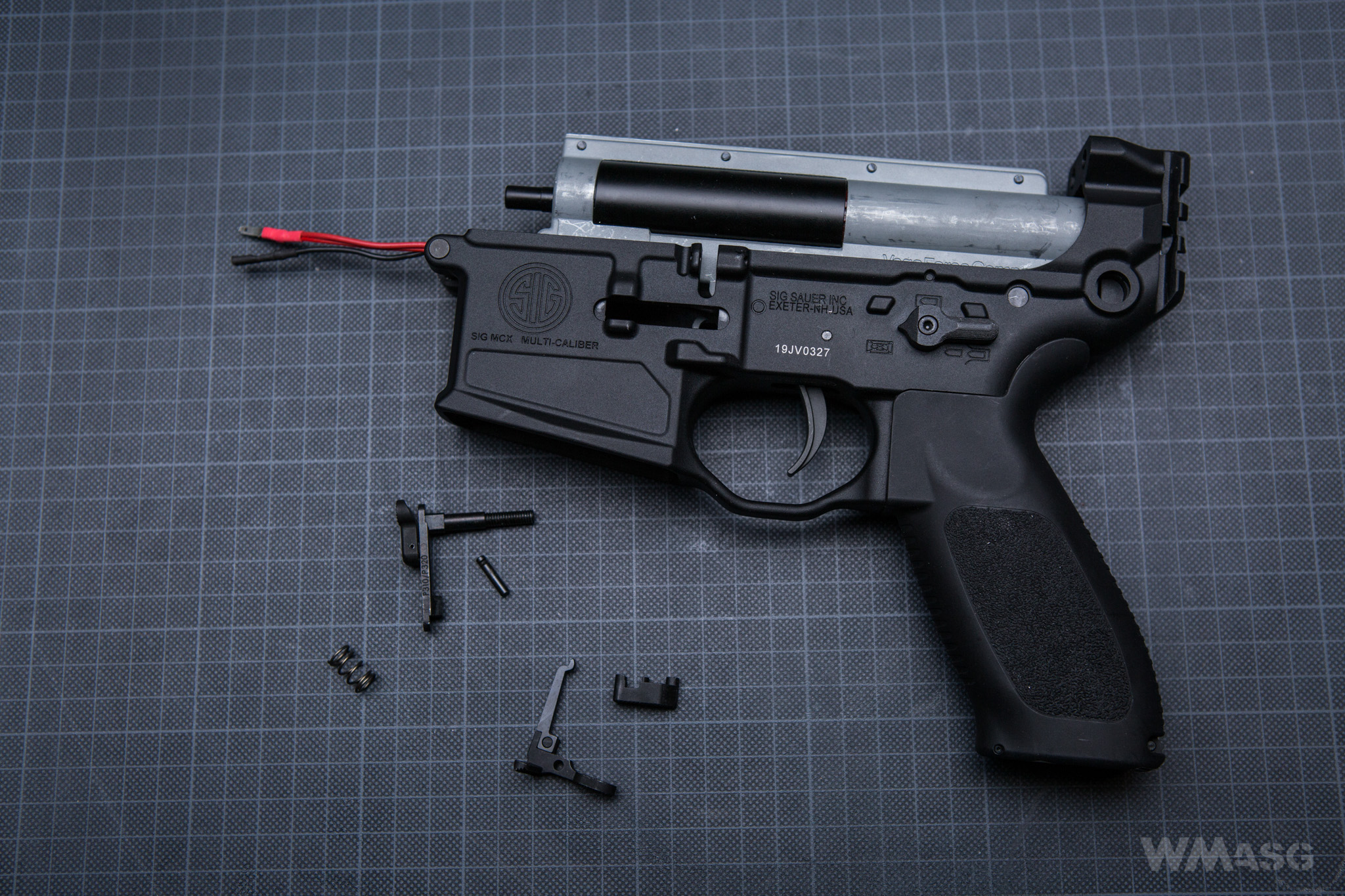
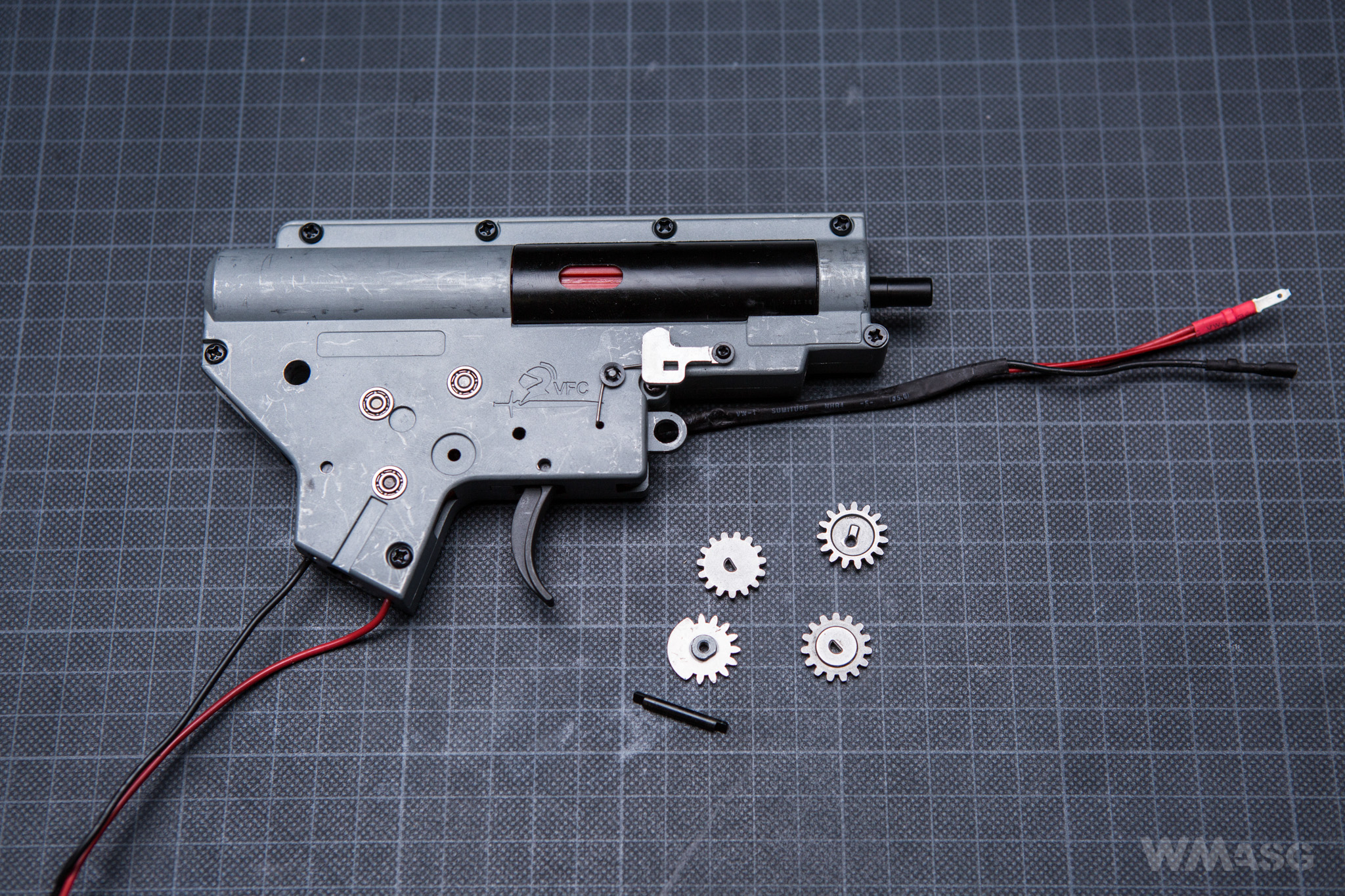
Inside the is almost nothing surprising. What we have are standard VFC parts: sintered gears, a piston with 7 steel teeth and an aluminum flat piston head and a nozzle with an O-ring.
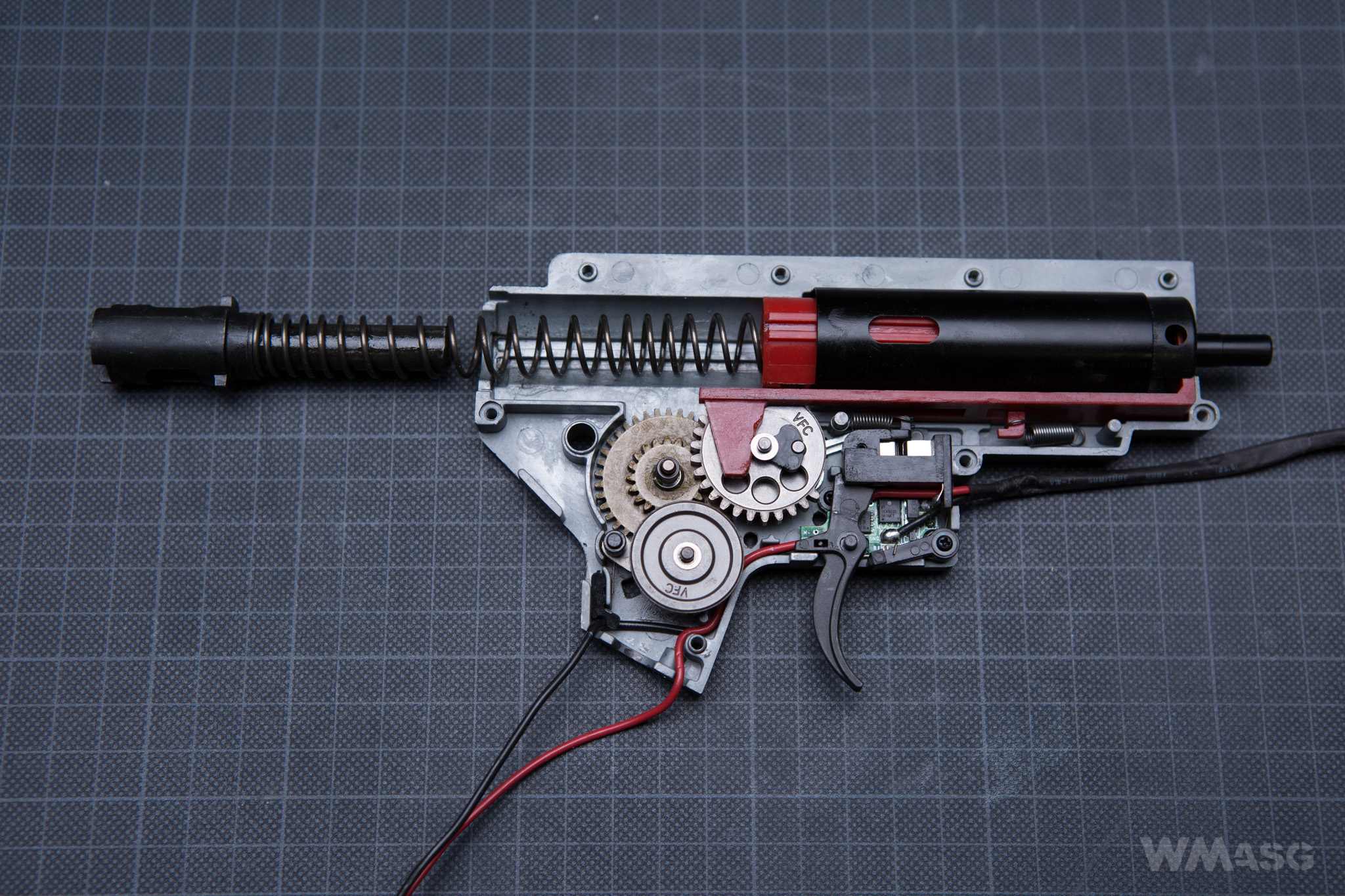
The only unusual part is the spring guide, in which the role of the bearing is performed by a rotary sleeve. It is a monolithic part that acts also a piece of the rail on which the stock is mounted.
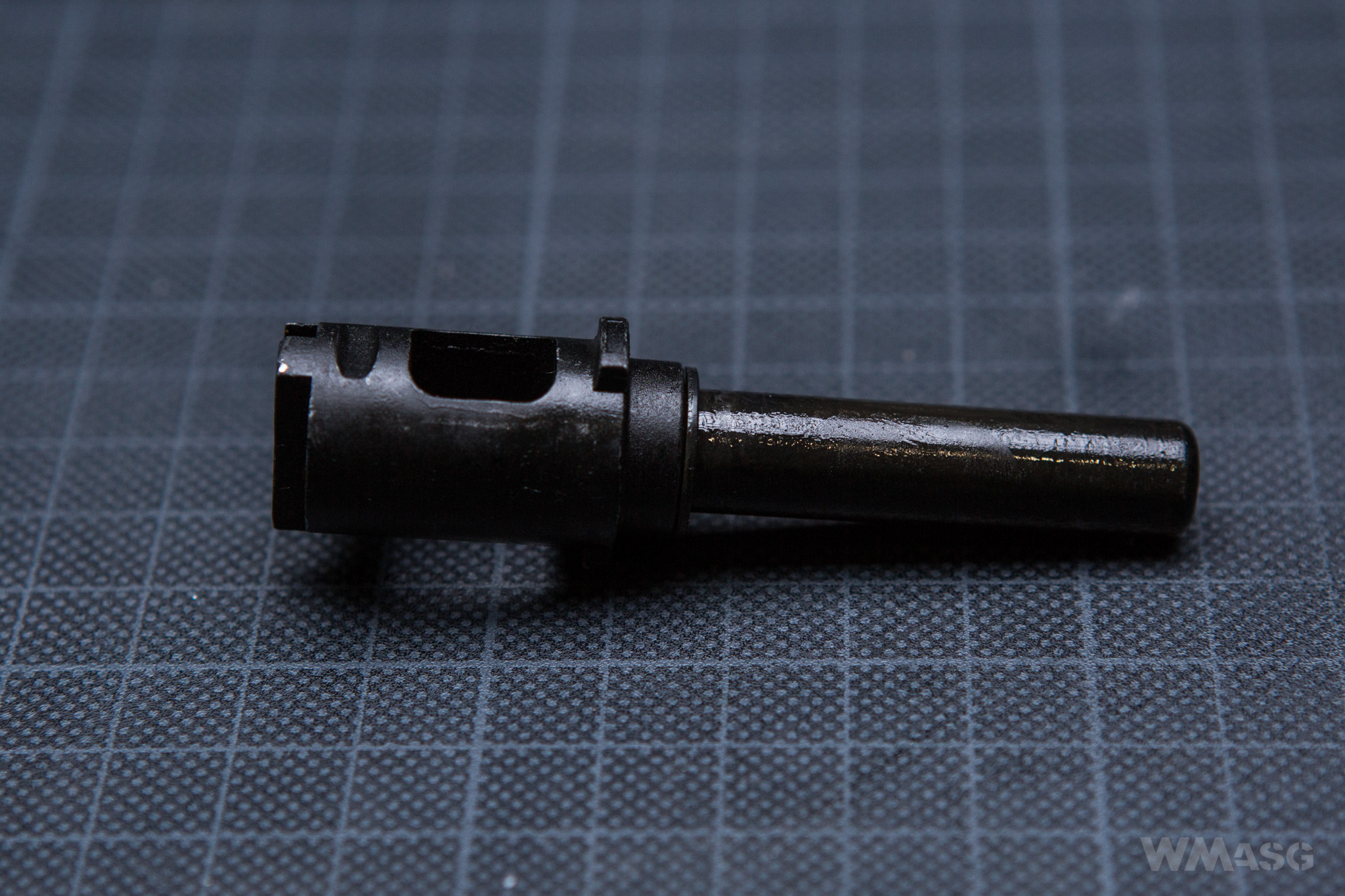
The replica is controlled by a hybrid contact switch with an integrated mosfet.
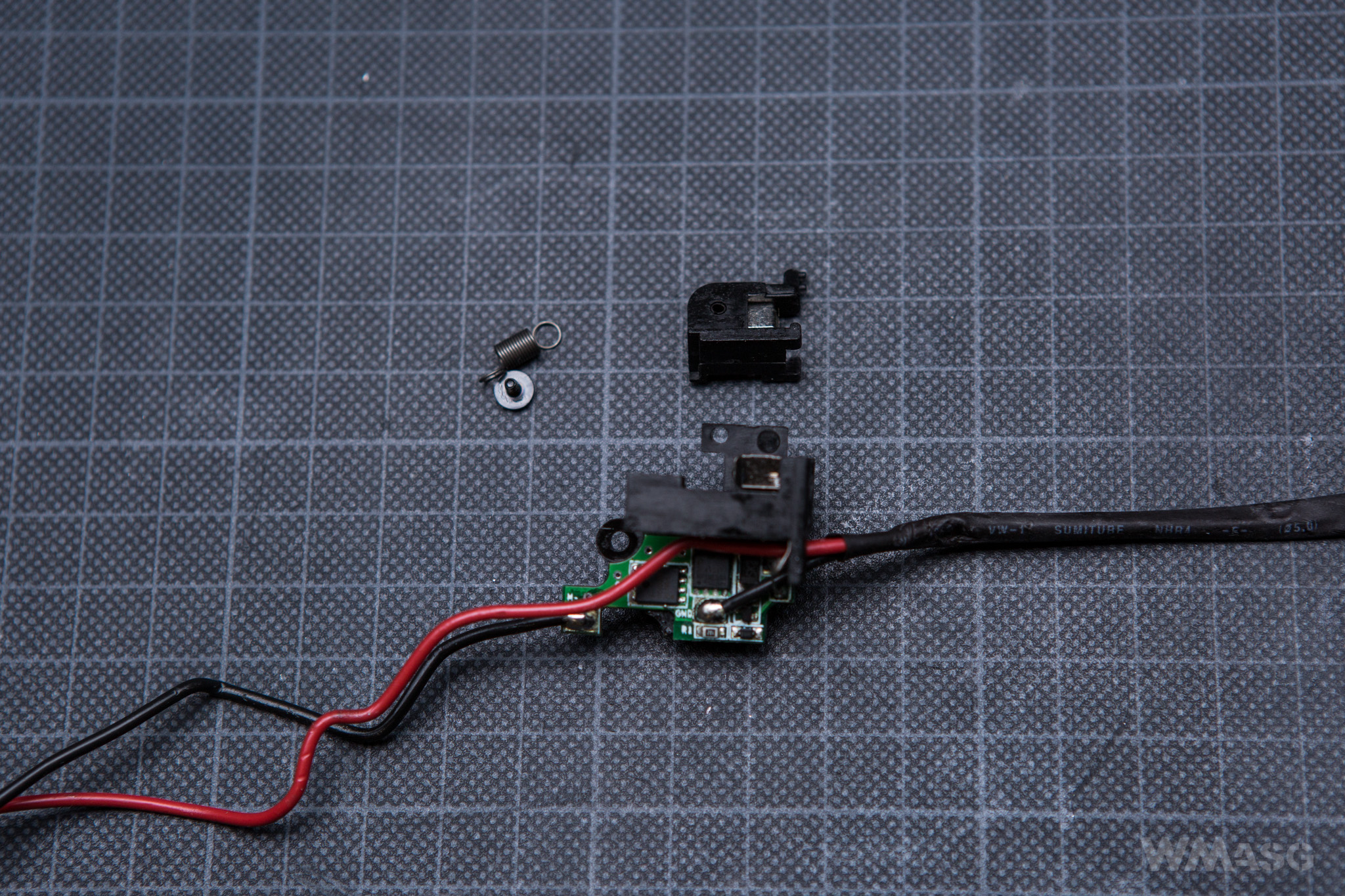
And everything would be OK! were it not for a thin, non-insulated signal (control) wire.
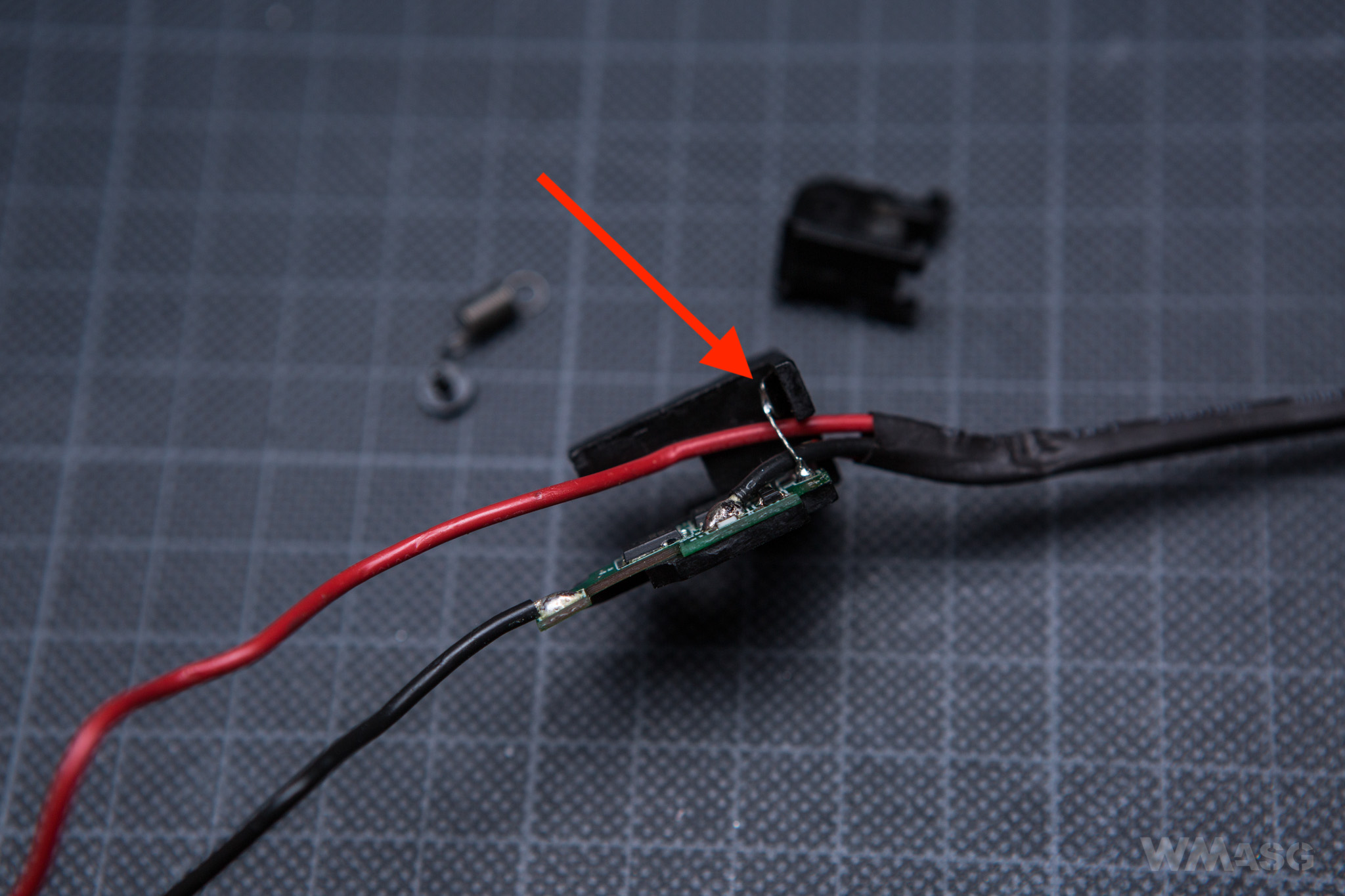
It works and probably will for a long time, but it does not look very robust. This bit could have been done in several more elegant ways.
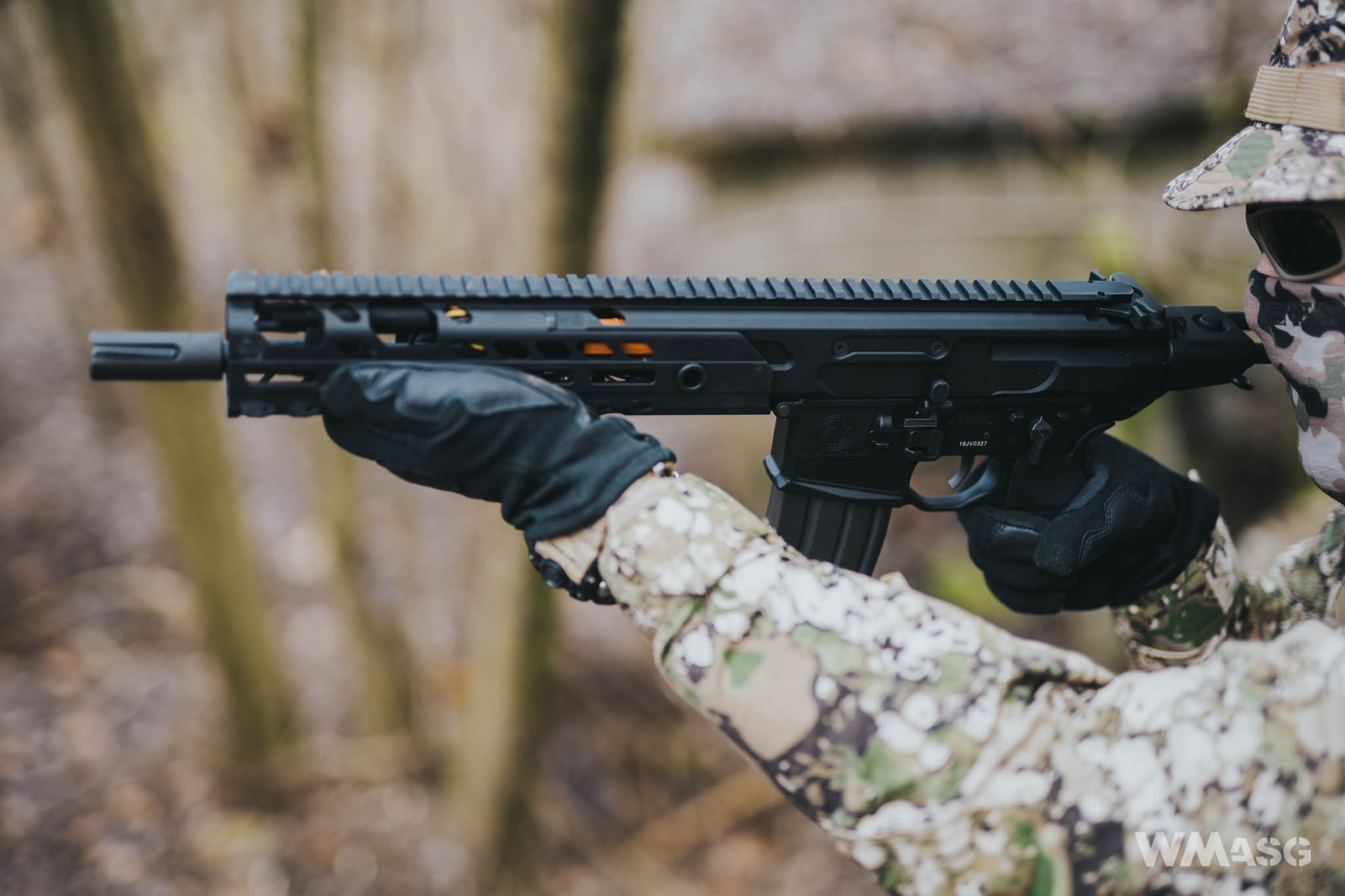
Target shooting test and muzzle velocity test
In terms of ergonomics, the replica is not surprising . In this respect it works like any other AR. The placing and operation of the manipulators is exactly what we have already got used to. Yet, the short stock remains a problem. You can get used to this, but I don't know if I would like to. On the mechanical side, it's hard to pick at anything, but the gearbox worked rather loudly. Not that something was wrong with it. But was not smoooooth. The problem turned out to be the magazine, or more precisely, some difficulty in inserting it. Due to the way the wires were routed in the reviewed replica, the magazine did not go deep enough into the magwell and it had to be pushed in with considerable force to become secured. In the long run it is unacceptable, because after a few attempts you can see the deformation of the wiring insulation. Slightly different cable routing did the trick.
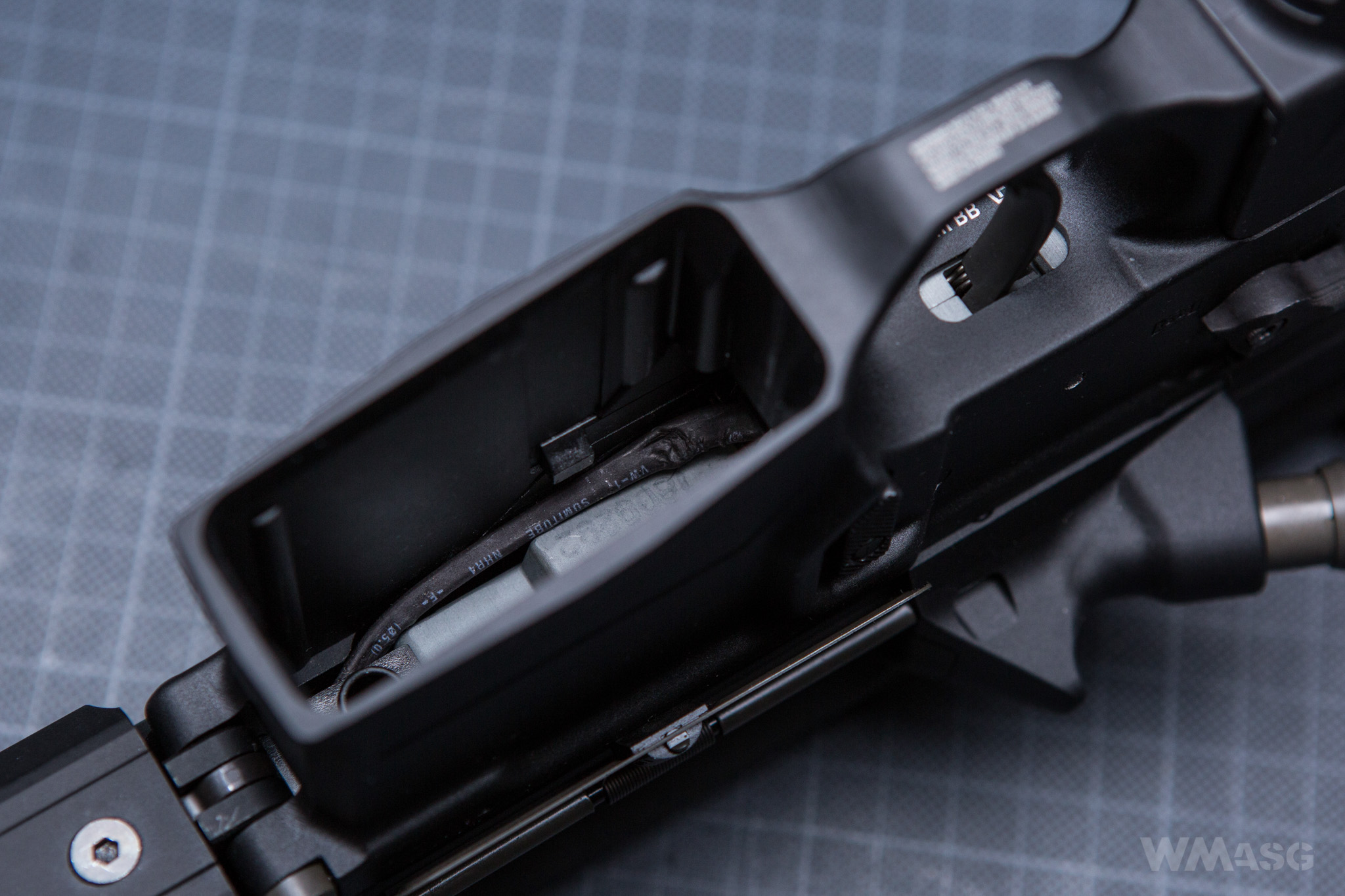
Muzzle velocity test
OpenBlaster 0.2 g BBs, ambient temperature of about 20°C, HopUp set to zero.
Muzzle Velocity:
1. 412.0
2. 410.3
3,412.2
4,412.0
5,408.9
6,411.5
7,411.8
8. 407.8
9,407.0
10,409.0
An average of 410.3 fps. It was, on average, 10 fps higher than the muzzle velocity declared by the manufacturer.
Spread: 5.2 fps, which is great.
Measurement results on the second spring that came with the replica.
1. 412.0
2. 410.3
3,412.2
4,412.0
5,408.9
6,411.5
7,411.8
8. 407.8
9,407.0
10,409.0
Target shooting test
Adjusted Hop-Up, G&G 0.25 g BBs, distance to the target was 25 m.
Single fire
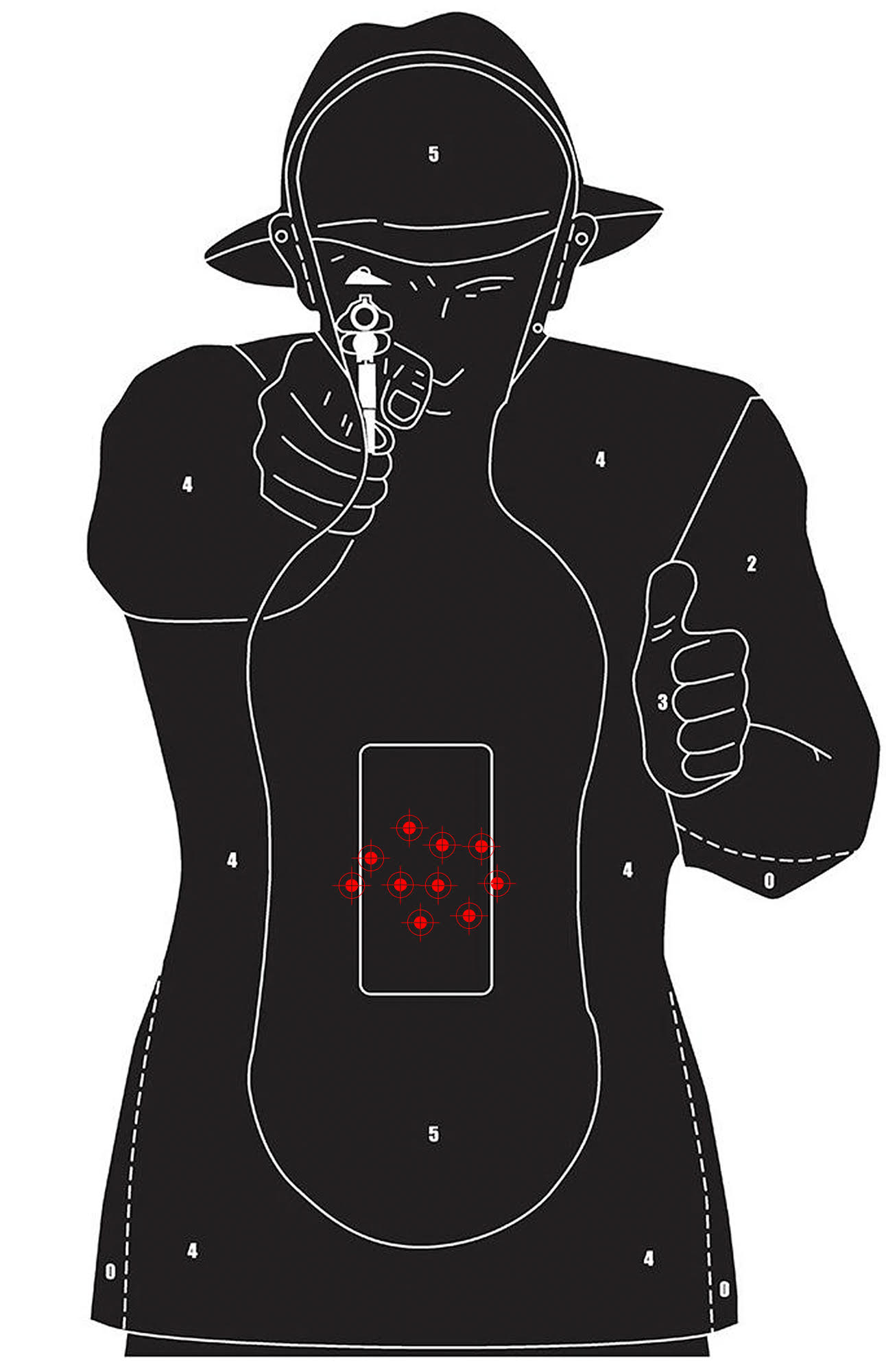
Full-auto fire
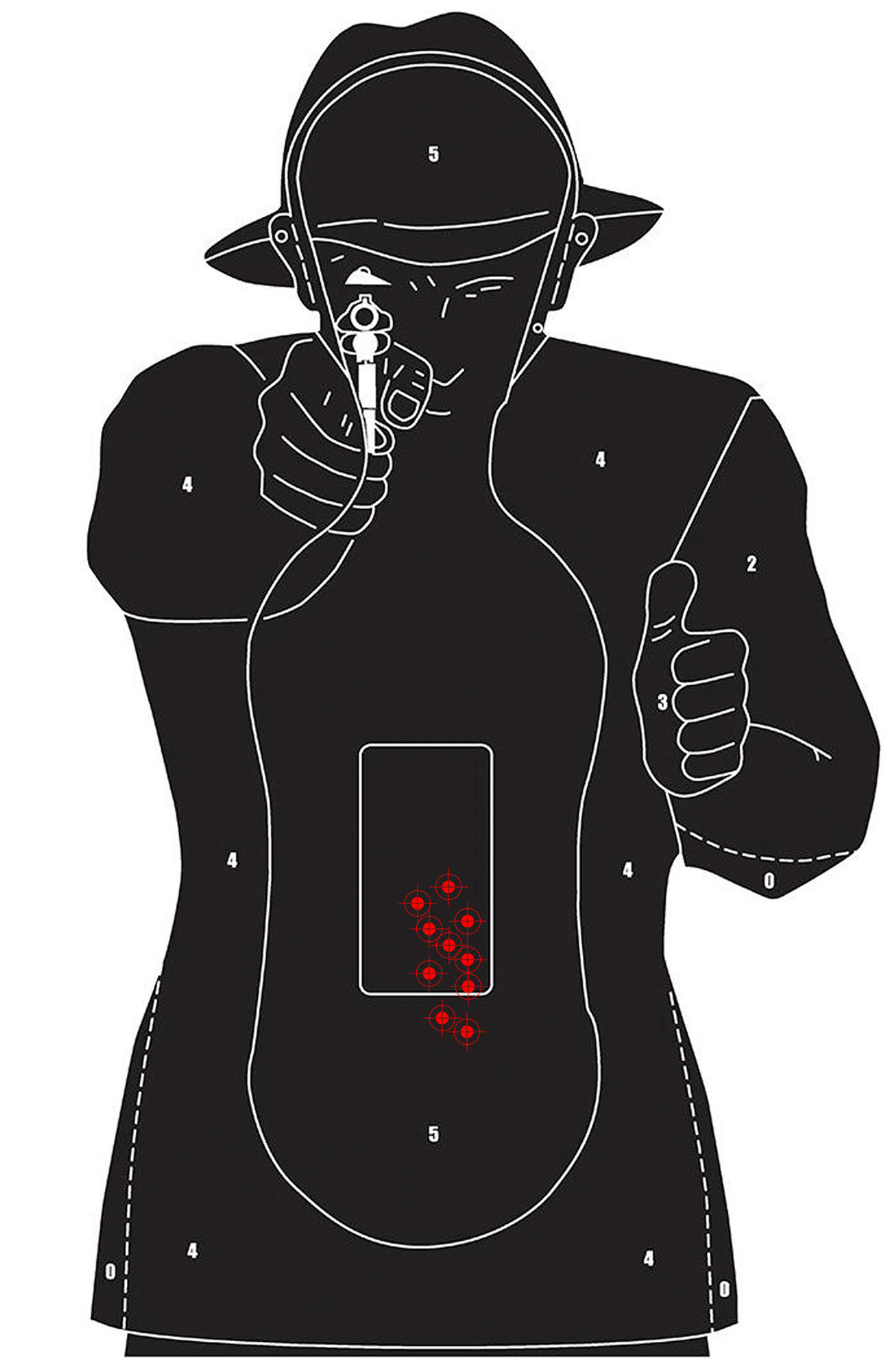
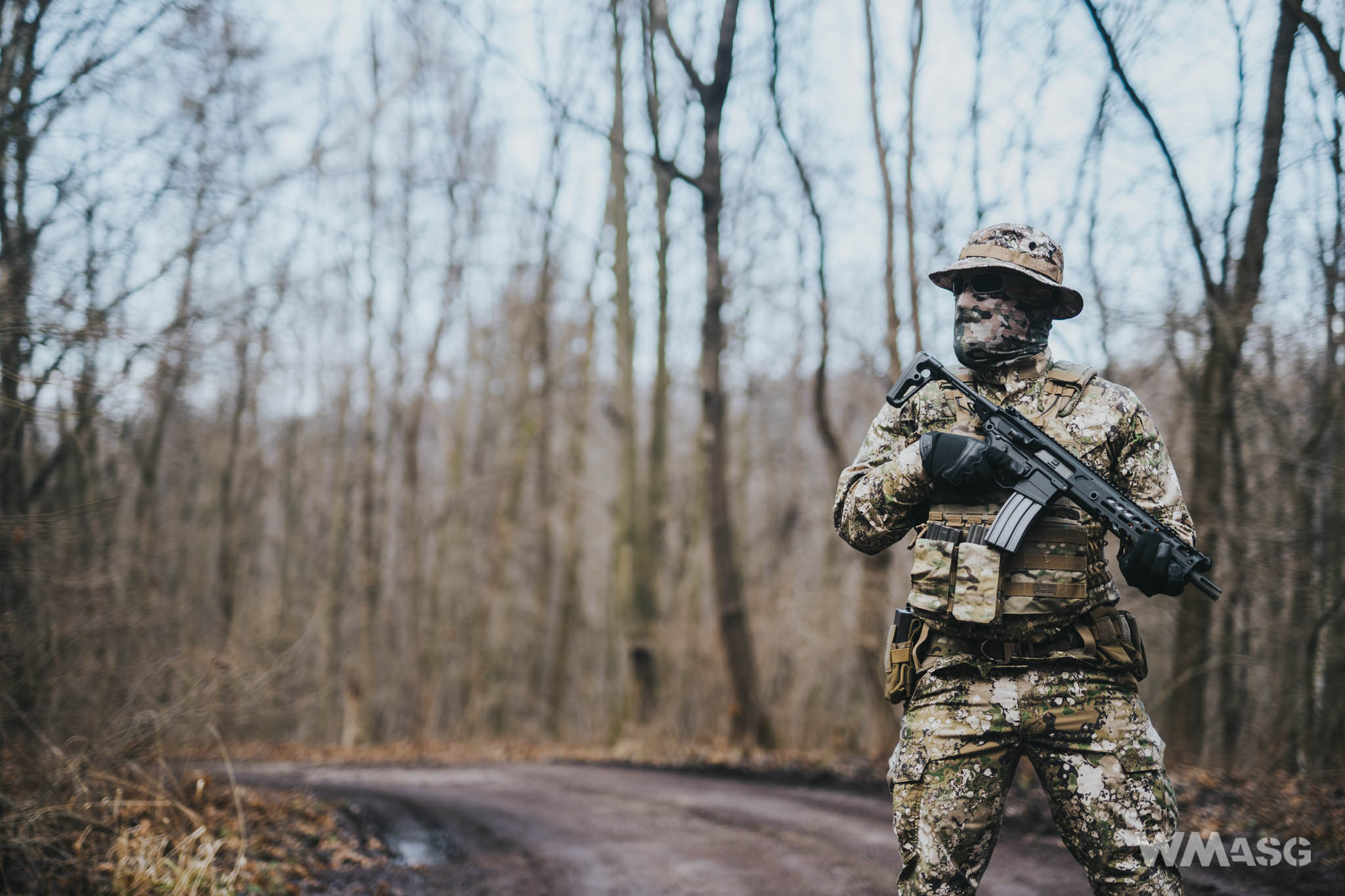
Summary
We waited impatiently for the Virtus since the day of its release. Was the replica we received expect what we had expected? From the visual side, definitely yes! We hoped that VFC would be up to the challenge as usual. And indeed it was. In our opinion, from the visual side you cannot pick on the new MCX too much. And how about the usability? Well, after a while it turned out that the handguard was wobbling and the varnish coating is very susceptible to scratches. It is particularly visible on the handguard and the adjacent receiver and barrel parts. The first scratches appeared immediately after connecting the battery, and we did not do it particularly gently. In our opinion, the solution of placing the battery in the handguard is also a slight downside. Also, from the marketing standpoint, selling a replica lacking any kind of sights is not a very good idea. Of course, this is not the first replica sold without sights, but this one is priced at 400 USD.
Will the market accept the Virtus? Certainly. Partly because the real carbine is strongly promoted, especially in the US, and in a moment the world will probably go crazy about the Sig, as it once went crazy about the HK416. Than any faults or deficiencies will be of little consequence.
More photos are in the attached galleries.
The photo of the Sig MCX Virtus Pistol was taken from sigsauer.com
On the next page you will find technical details
